-196 Holden Special Sedan (1963-70)
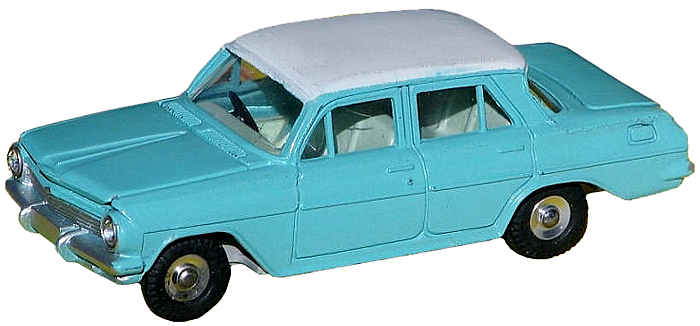
Photo Bruce
Dave
I know your post is old, but reading through this Thread I came across it, and thought I would include a photo of my 196 Holden Special Sedan, still secured in its export box by its rubber bands. You will note that the Holden was in the first batch produced in turquoise as Meccano were using up the bronze painted bonnet/hood, and boot/trunk from the first issue.
Bruce
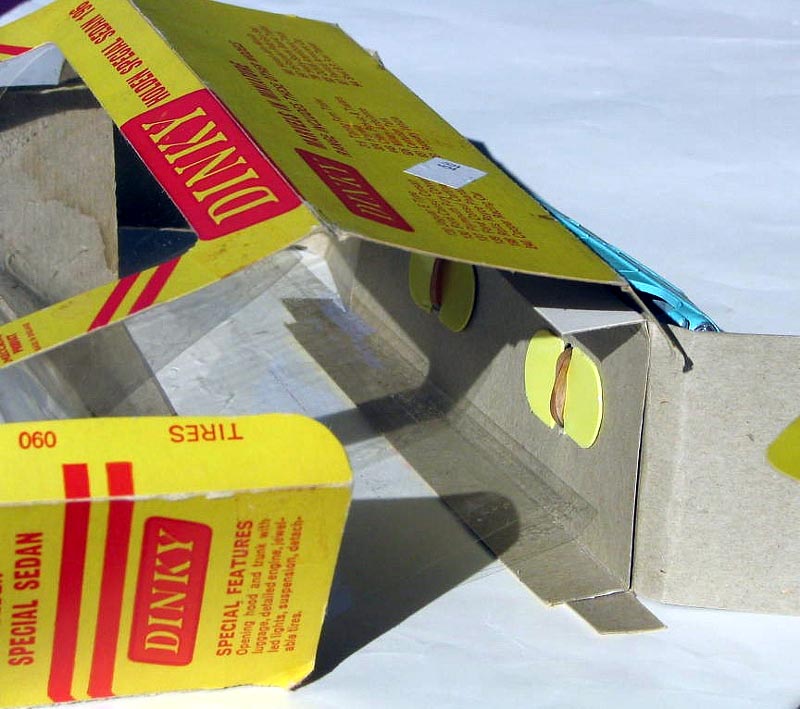
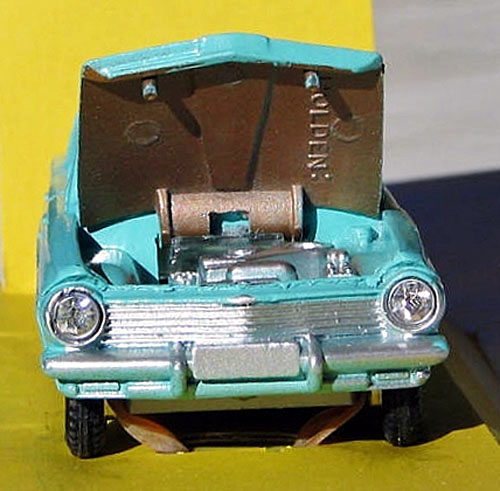
__________________________________________________________
Note that this box is printed in American, not in English. see "tires 090" on one of the flaps. I can also read "hood".
Jacques.
__________________________________________________________
That does not really make sense as the Holden was an Australian Car and not an American.
Surely the Aussies used proper, old fashioned, English.
Dave
p.s. I hope I am not opening a can of worms here !!!
__________________________________________________________
Obviously printed in England for the American market so use the American terminology. That is why I mentioned hood and trunk in my last post although I had not noticed the use of the American English "tires" for the British English "tyres". Also there is no other languages included. With Canada next door, did they receive their stock direct from Liverpool or from Hudson Dobson? If the latter, the box did not include French, suitable for Quebec, Canada, which is why I think Canada may have obtained their stock direct from England.
By the way, I have never touched the intact rubber band still holding the "right-hand drive" Holden in its box. Guess one could call this model truly mint and boxed!
I also made reference to the bonnet/hood and boot/trunk having the original bronze colour from the first issue. Note that the model also has the original interior rather than red that was later used.
Bruce. 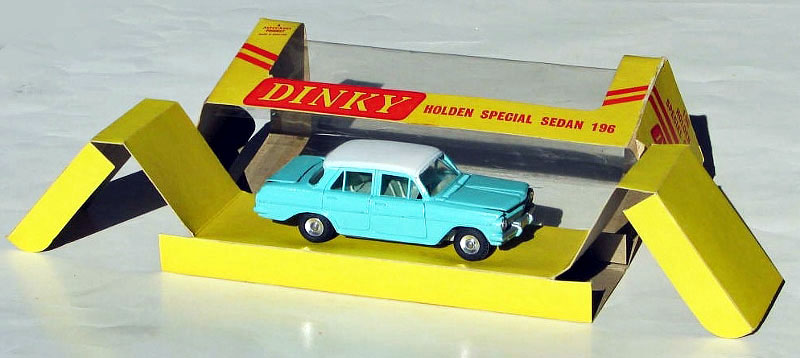
__________________________________________________________
Dave,
Printing the box in American English does make sens as these boxes were meant for export to the U.S. Models sold in other countries were packed in end flaps boxes.
Bruce,
__________________________________________________________
The export department in Liverpool must have been split into several sub departments for : Europe, Commonwealth, USA etc.
There is evidence in some catalogues that the source for Hudson Dobson was different from the Canadian one (part of the Commonwealth). French made Dinky were exported to the US and not to Canada. So the yellow and the gold Visi-Pacs as Meccano called them may not have been available in Canada at least at the begining. This expains why they were not printed in French for Quebec.
I would apreciate a photo of the end flap showing the "Special features" and the tire reference as well as one of the model taken 3/4 front left so that one can see the light green seats.
There are other examples of models been overpainted like the Hood and trunk of the Holden, some french Dinky trucks have been finished in that way. I can not remember which.
Jacques.
__________________________________________________________
Jacques
Hope the attached is the angle you required. I will have to photograph the end details tomorrow and will post it when done.
Bruce
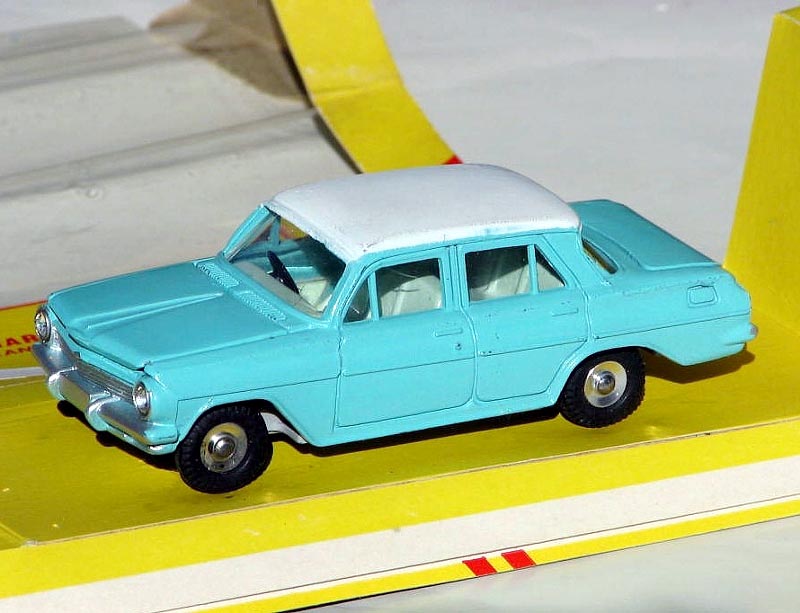
__________________________________________________________
Bruce,
That is a great picture. I would also like to know if the interior is greenish or blueish and the colour of the base plate.
Thank you.
Jacques.
One starts with two variations : bronze and turquoise and one finds that there may be more than half a dozen :
1) Bronze body greenish interior, grey base plate.
2) Turquoise body greenish interior over painted boot and bonnet lids, grey base plate.
3) Turquoise body red interior over painted boot and bonnet lids, grey base plate. (possible variation)
4) Turquoise body red interior over painted boot lid, grey base plate. (possible variation)
5) Turquoise body red interior over painted bonnet lid, grey base plate.
6) Turquoise body greenish interior, grey base plate. (possible variation)
7) Turquoise body red interior, grey base plate.
8) Turquoise body red interior, black base plate.
In green the confirmed variations.
How is your's ?
Thus may be a ‘loaded’ question. There seem also to be luggage variations, from small suitcase in green or brown, to a larger case?, and finally green or brown trunks. Perhaps the latter came with the window box ?
Jacques
Glad you liked the last picture.
Thank you too for creating this new thread, although I was intending to do likewise, but you beat me to the punch!
Anyhow, thought I would add some more pictures of the Holden, to add to those you transferred from the New Arrivals thread:





Hold up Jacques with your latest post - I am about to add a further variation, that will turn one of your suggestions into green, but first, I have to do the washing up! :unsure: Am having trouble keeping up with your posts!
Bruce (150)
Here is another variation of the turquoise and white Holden. This one has the normal red interior, grey die-cast base plate, but the bonnet is still painted bronze underneath and is housed in the standard 196 Holden Special Sedan box. 




Unfortunately, I sold this model through Wallis and Wallis in 2011. Hopefully, a member or other Dinky Toys collector who won this model together with an AC Aceca in cream and dark brown Lot 429 in the Wallis & Wallis sale of 23 June 2011, may see this post and be able to check it and get back to this Thread!! By the way, whoever the winning bidder was, he got an absolute bargain, as the lot went for ninety five pounds plus commission. I have been kicking myself ever since as these were not the only models of mine that went for a song that bleak and dark day!! :(
This is the normal/usual version of the turquoise and white 196 Holden Special Sedan.
But first a word from Dave, pinched from New Arrivals thread
Re:New arrivals 13 Hours, 4 Minutes ago Karma: 6
That does not really make sense as the Holden was an Australian Car and not an American.
Surely the Aussies used proper, old fashioned, English
Dave
ps I hope I am not opening a can of worms here!!!
Dave
You will see on the usual box, that we do speak and write the Queen's English out here, although recent years has meant we are slowly losing it, with some changes taking place, program instead of programme, theater instead of theatre, jail and no longer gaol, yeeks, I am changing the thread!! 

But this example now has a black diecast base plate.

I guess this thread should have started with the original issue, in bronze with white (sometimes an off-white) roof. This model was released in September 1963, to mark 50 years of Meccano in Australia. Meccano worked in closely with General Motors-Holden in Melbourne, Victoria who provided basic drawings of the prototype that had been in production for about a year. The car was officially referred to as the Holden EJ Special Sedan, the model superceding the Holden EK.
However, when it came to the suggested colour scheme, GM-H provided samples, and Meccano selected bronze. However, unbeknown to the fellows at Meccano, they had actually selected the colour scheme for the Holden EJ Premier Sedan, an up-market version of the Special Sedan. This was the first model in the Holden family to have a luxury model added to the range, thus acquiring the title "Premier", with front bucket seats, metallic paint, automatic transmission as standard (rather than an option as on the Special Sedan), heater-demister, and arm rests. (Not much comparing the features in today's cars!)
So we have a mistake with the paintwork, which could have been rectified by simply changing the box, whoops, and the base plate. So the bronze colour continued until Meccano had exhausted the supply of this paint by the beginning of 1966. The second edition of the 1966 catalogue, effective from 21 July 1966 has the Holden in turquoise and white, a colour scheme that I have my doubts was seen on this model, although the 1966 Holden HD, a totally different designed motor vehicle appeared in turquoise and white. The catalogue no doubt reflects the period when the colour changed to turquoise and white.
The model was fitted with jewelled headlights and tail lights, the first in the Dinky range to have this feature, opening bonnet and boot (hood and trunk for our brethren in North America!) It was fitted with the smaller Type 2 turned aluminium hubs and its base plate was diecast and painted light grey. The interior seats were a very pale blue, sometimes referred to as "duck-egg blue".
The Holden was exceedingly well cast, in particular the quarter and three-quarter side window pillars. Today's excellent 1/43 scale models, having finer details, do not include cast pillars for the side windows, instead opting for a transfer. So the casting skills of the Meccano workers in the 1960s far exceeded those in China today!




Jacques
Referring to your question some time ago, the base plate for the model at the start of this Thread is light grey as per the bronze and white version. The interior is also identical to the bronze version, a very pale blue, or as someone referred to it as "duck-egg blue". I have not forgotten about the photograph you want in this thread showing the end flap and tyre details.
Finally, Jacques can you explain how the painting process worked with the Holden and its bonnet and boot? If these items had been previously painted for the bronze version, how is it that only the upper was painted turquoise? Is it possible these had been fitted to the model and then the upper was given a quick spray to match the rest of the model?
Bruce (150)
Bruce,
I do not know how these were painted. It is not possible that the boot and bonnets were assembled to the body before painting because they are held by the windows which are held by the base plate.
I know three ways of painting used by Meccano :
1) the painting knobs
2) the x'mas tree
3) grills
I will explain later today, I must clean the garden while it is not raining.
The following is a quote from a post submitted by Jacques some time ago:
The export department in Liverpool must have been split into several sub departments for : Europe, Commonwealth, USA etc.
There is evidence in some catalogues that the source for Hudson Dobson was different from the Canadian one (part of the Commonwealth). French made Dinky were exported to the US and not to Canada. So the yellow and the gold Visi-Pacs as Meccano called them may not have been available in Canada at least at the beginning. This explains why they were not printed in French for Quebec.
I would appreciate a photo of the end flap showing the "Special features" and the tire reference as well as one of the model taken 3/4 front left so that one can see the light green seats.
There are other examples of models been over-painted like the Hood and trunk of the Holden, some french Dinky trucks have been finished in that way. I can not remember which.
Jacques.
Jacques
I have finally got around to photographing the end flap and another showing the tyre/tire reference.


It is to be noted that the tire/tyre specification was only printed on one of the main tuck-in flaps.

The large cardboard side that I had neglected to include previously is below. The only interesting thing is the small ticket that has been stuck to it with the numerals "68". I do not know what this means, but perhaps it could denote 1968.

Bruce,
Thank you for the nice pictures.
In early July 1963, Meccano Dealers were sent a copy of the July-August-September Meccano Trade Bulletin that provided them with advance notification of six new Dinky Toy and Supertoys releases. One of these was the "196 Holden Sedan Car - THE CAR FROM DOWN UNDER!" Of course the model's title became the 196 Holden Special Sedan when it was released in September 1963, to mark 50 years of Meccano in Australia.
Here is a copy of the advertisement in the Bulletin that also included the 117 Four Berth Caravan that was released in August 1963.
Bruce (150)
#500

Hi all,
Lovely looking car the Holden Special, did it share floorpan etc with the PB Cresta?
Chris Warr.
Greetings Chris
Many thanks for your comments on the Holden EJ. Actually, the next version the EH was a big improvement.
No - the Holden did not share a floor plan with any other vehicle. It was totally designed and engineered at Fisherman's Bend, near Melbourne, Victoria, Australia. Its predecessor the FB/EK was right up with the Americans - tail fins and wrap-around windscreens. General Motors-Holden built a fantastic testing ground at Lang Lang southeast of Melbourne, and all new designed Holdens from the 1958 Holden FC right through to the current Commodore (no, not the Opel one, although our Commodore had its roots with the Opel one!) were tested and modified through this test facility. In recent years, the Pontiac GTO was a re-badged and re-engined Holden Monaro, made in Victoria, Australia.
Unfortunately, by 2017, General Motors-Holden will no longer manufacture or assemble cars in Australia. Their role will simply be to stick a Holden badge on appropriate products being made elsewhere by GM, such as the Opel Astra. The one redeeming factor will be the retention of the design and engineering department for a lot of GM products with the proving ground at Lang Lang being retained. Ford and Toyota like GM-H will also cease manufacturing in Australia. A sad end through globalization.
In the 1950s, we had three manufacturers, GMH, Ford and Chrysler and a multitude of assemblers, BMC, Rootes, VW and others, all when we had a population of 9 million. Now with 22 million approaching 23, apparently we do not have the population to support a single car manufacturing and component industry! Unfortunately, cars will continue to be made in countries where the workers do not enjoy the same conditions as here, and whose pay packet is far less, resulting in a bigger profit for the multi-national manufacturers. But I guess this is the same story that has been repeated elsewhere, GB, etc.
There - I have said my piece!
Kind regards
Bruce (150)
#501
Chris
Just adding something to my Post dated 23 March 2015. In 2017, production of cars in Australia by General Motors-Holden's ceased on 20 October. From then on Opel Insignias were imported from Germany. They were re-badged with Australian Design Rules before being shipped, so Australians were not even "permitted" to stick the Holden badge on them! With GMH continuing with the Commodore nameplate, they assumed the Holden loyalty would continue. They made a very serious error of judgement, as sales of the "new" 2018 model Holden (Opel) Commodore were dismal, in fact GMH requested the factory to cease sending more vehicles in 2019 due to an over-supply of Commodores that had not been sold. Talk about stupidity of the first order! Had the company imported the Holden Commodore's replacement, leaving it with its original nameplate, perhaps sales may have been better.
However, on 17 February 2020, General Motors announced the name "Holden" was being retired, and the company would move out of manufacturing vehicles with Right Hand Drive. (Not sure if the same applies to the Vauxhall factory in the UK.) GM considers the RHD market to be too small to warrant making any more vehicles in this style, leaving just LHD vehicles to continue. Ford has not as yet gone down that road as yet.
Now we come to the best part of this Post!
On 20 October 2017, the day the Holden factory closed, I took delivery of my first new Holden Commodore SV6. My car was manufactured on 20 March 2017, and the factory supplied me with several photographs of it on the production line. How nifty is that?!
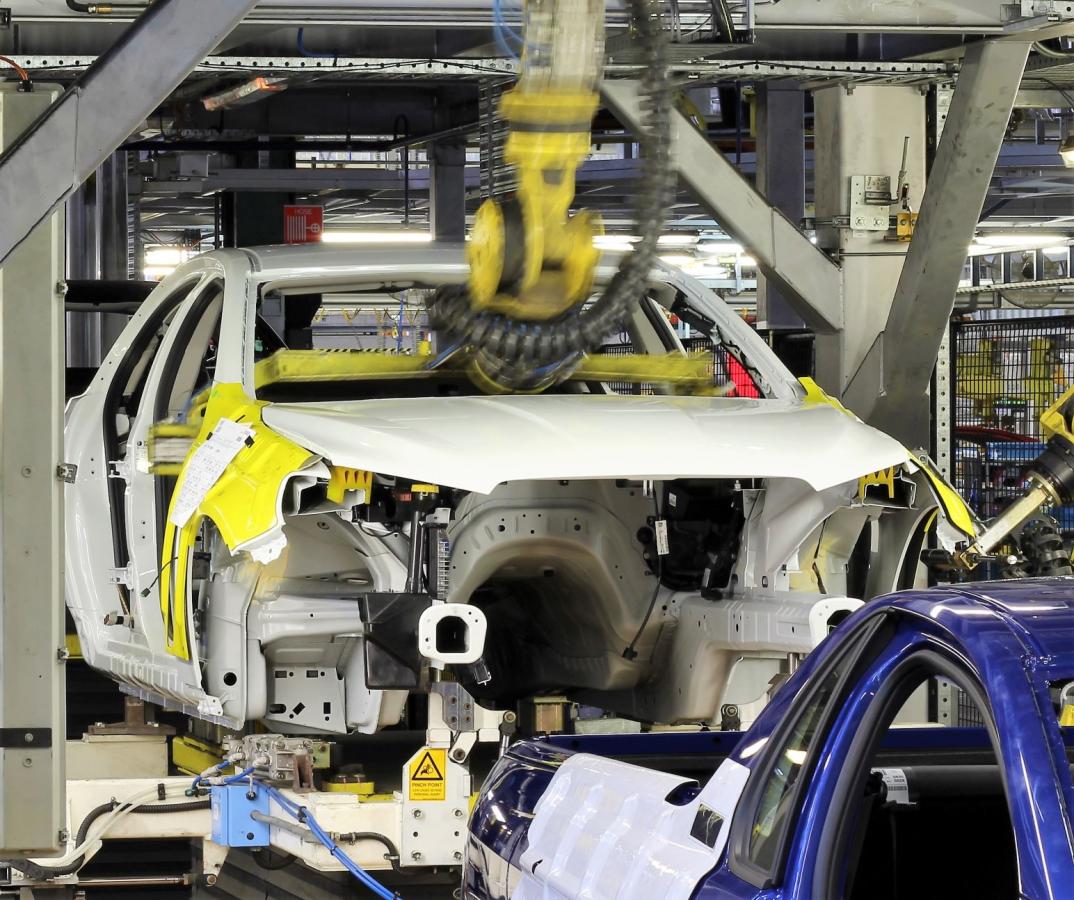 and here is "Holly",
and here is "Holly", 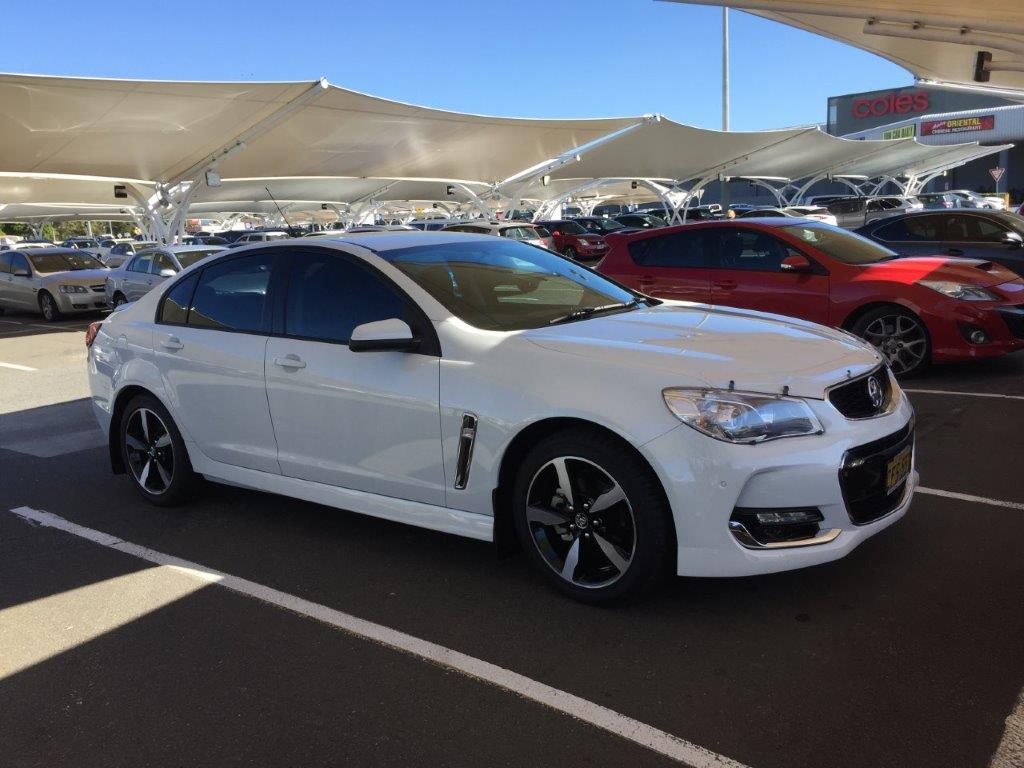
It is such a terrible shame the factory is now a thing of the past, as this model, manufactured in 2017, has an incredible array of features; head-up display on the windscreen, automatic reverse parking if needed, satnav, blind-spot alert, rear view camera, reverse directional traffic alert, smart remote engine start, plus all the usual features. And it is a real pleasure to drive with a fuel economy of 9.3 litres per 100 kilometers, and all with a 3.6 litre V6 engine.
And we no longer make them! A terrible shame.
Bruce (150)
20200505/1208/0309
Thanks Bruce,
Believe me I know how you feel, coming from the West Midlands, and growing up in the 60's / 70's it seemed everybody worked in car manufacturing or parts supply, now we have nowhere near that, Terrible shame.
BTW, a mate greatly improved his '64 PB Cresta by taking out that old straight 6 and dropping in a 350ci Chevy V8, NICE.
CW.
Greetings Chris and All
Thought I would include a couple of brochures issued by General Motors-Holdens on the Holden EJ. Please excuse the artists licence - the car was not as long as it appears here!
Bruce (150)
#510


Thanks Bruce,
That wagon is amazing! Pity Dinky didn't model that too, was there a ute?
CW
G
Mr Moderator
The above Post #17 is a real blast! I know I wrote more than just the letter "G" for Greetings, or Good Morning, etc!! In fact this Post contained information on other vehicles made by Holden, and included many photographs of the Holden Utility, and Holden Station Sedan.
So, until the rest of Post #17 can be brought back to the new website, the following are some of those missing pictures.
Kind regards
Bruce (150)
5 January 2016
#742
Thanks Bruce,
The panel van and Ute are really great, compared to the pick ups and car based vans we had in the UK at the time these are out of this world, our GM equivalent was the Bedford HA!
Chris Warr.
Thanks Chris. I tend to agree with your comments. The windowless panel van was nice too, although trying to find one that has been preserved has proven too difficult!
Anyhow, I think we need to go back to the beginning.
In the beginning, well actually, a little later than "in the beginning", but Meccano wanted to mark the 50th Anniversary of the presence of the company in Australia by producing a model vehicle that was unique to Australia. On examining the Australian motor builders, their choice was limited to three manufacturers, Ford with their Falcon, Chrysler and their Valiant, and General Motors-Holden's with their Holden. Of the three, only Holden was manufacturing a family sedan that was entirely (with limited input from Detroit) designed and built in Australia. Both the Ford Falcon and Chrysler Valiant were products of their parent company in the United States, with some modifications to suit Australian conditions. So Meccano then sought help from General Motors-Holden's with their product being entirely "Australian Made."
The Holden EJ on which the Dinky Toys 196 is based, was released on 30 July 1962 in three body types, Standard Sedan, Special Sedan, (the 196 Dinky Toys) and the Premier Sedan. The Standard model was the base version
Even Post #20 is incomplete, as this one provided information on the prototype vehicle on which the Dinky model was based. It is essential for all of this Post be brought forward - apart from the fact that I spent many hours preparing the text and selecting suitable photographs to accompany the text.
I cannot understand, or believe that some of that Post has been saved and the remainder not. But I can only hope that it was just a simple glitch and that all will be right in the end.
In the meantime until every bit of this Post has been brought forward herewith are pictures of the later version of the Holden Special Sedan and the real vehicle for the benefit of readers interested in the 196 Holden Special Sedan finally in a colour scheme that was applicable to the real car!
Bruce (150)
5 January 2016
#743
Bruce--Great Holden photos....many of us have never seen many Holden's before, so thanks for posting!
Best regards, Terry
Wonderful! Thanks Bruce!
Great lot of info there. I've had lots of American cars over the years, and am pretty clued up on them, but my knowledge of Australian cars is pretty poor. Something to work on!
Anyway, I saw a Bayko house in the Meccano advert, and as I just happen to have one built, and a Holden....
Chris Warr.
BTW; I'm a huge fan of Bayko, I've bought tons of it over the years, is it relevant to start a Bayko post here? Anybody interested?
Love that scene with the Bayko, Chris!
I only have a tiny amount of Bayko (enough to make one small house), but I'd love to see some more of your Bayko.
Fred7A wrote:
"Love that scene with the Bayko, Chris!
I only have a tiny amount of Bayko (enough to make one small house), but I'd love to see some more of your Bayko."
Cheers Fred,
I'll get some pictures done, I'll put them in a new thread later.
Chris Warr.
Greetings all
Returning to the 196 Holden Special Sedan (aka Holden Premier Sedan!) the engineers, tool-men, and all those associated with preparing the die, performing the casting operation, etc, were light-years away from those making die-cast models these days, now mostly in China. We often read of the skills etc from the Chinese plants, but look carefully at the following picture. It is of a fairly recent model in the Trax (Australia) range, depicting the same Holden EJ that Meccano produced 40 years previously. Notice the quarter front side window vent and the three-quarter fixed rear window. With the Dinky version the frames for these two side windows are die-cast metal. The modern version is simply a silver transfer.


Although giving credit where it is due, the modern version has realistic wheel rims, and perhaps the casting itself may be superior, nonetheless, this model has been made exclusively as a COLLECTOR'S MODEL, not as a TOY! And Meccano, and its skilled workers, was still able to cast the model with metal frames for the side windows.
Cheers
Bruce (150)
#544
6 May 2015
Holden images recovered from the old website backup folder


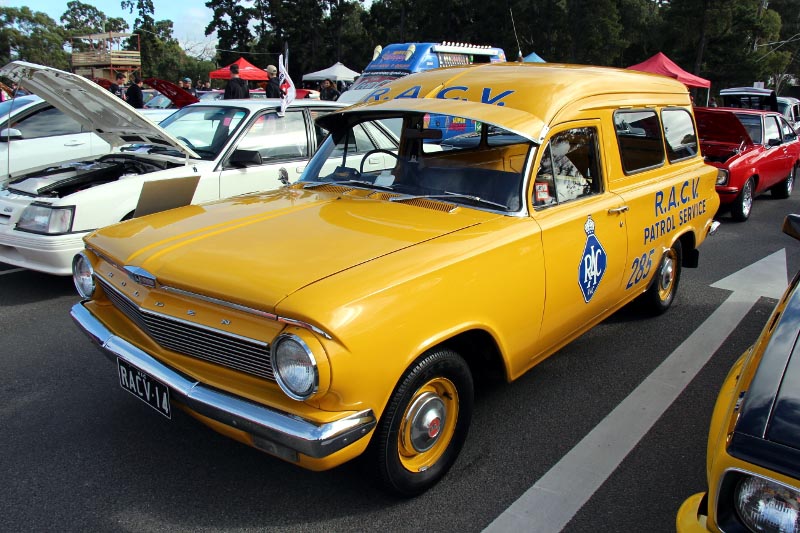

And a Holden Commodore
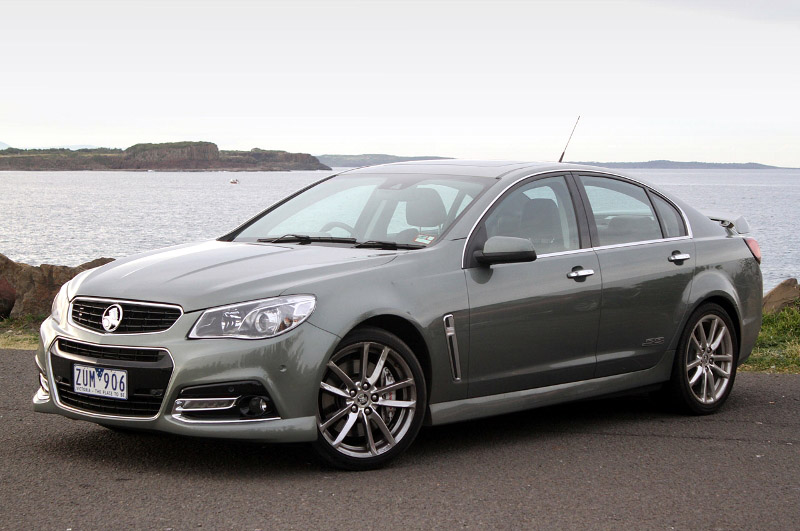
Al
Thank you very much for resurrecting the above images - most appreciated. I have an email under preparation as a result of our recent communication.
Basically, I have located a copy of the Post in which the above images formed part, so will post this discussion again, together with additional images.
Kind regards
Bruce (150)
11 February 2016
#764
There now follows a restoration of this thread to compile some previously displaced information
3997 dinkycollect

Photo Bruce
Dave I know your post is old, but reading through this Thread I came across it, and thought I would include a photo of my 196 Holden Special Sedan, still secured in its export box by its rubber bands. You will note that the Holden was in the first batch produced in turquoise as
Meccano were using up the bronze painted bonnet/hood, and boot/trunk from the first issue. Bruce


Note that this box is printed in American, not in English. see \"tires 090\" on one of the flaps. I can also read \"hood\". Jacques. That does not really make sense as the Holden was an Australian Car and not an American. Surely the Aussies used proper, old fashioned, English. Dave p.s. I hope I am not opening a can of worms here !!! Obviously printed in England for the American market so use the American terminology. That is why I mentioned hood and trunk in my last post although I had not noticed the use of the American English \"tires\" for the British English \"tyres\". Also there is no other languages included. With Canada next door, did they receive their stock direct from Liverpool or from Hudson Dobson? If the latter, the box did not include French, suitable for Quebec, Canada, which is why I think Canada may have obtained their stock direct from England. By the way, I have never touched the intact rubber band still holding the \"right-hand drive\" Holden in its box. Guess one could call this model truly mint and boxed! I also made reference to the bonnet/hood and boot/trunk having the original bronze colour from the first issue. Note that the
model also has the original interior rather than red that was later used. Bruce.

Dave, Printing the box in American English does make sens as these boxes were meant for export to the U.S. Models sold in other countries were packed in end flaps boxes. Bruce, The export department in Liverpool must have been split into several sub departments for : Europe, Commonwealth, USA etc. There is evidence in some catalogues that the source for Hudson Dobson was different from the Canadian one (part of the Commonwealth). French made Dinky were exported to the US and not to Canada. So the yellow and the gold Visi- Pacs as Meccano called them may not have been available in Canada at least at the begining. This expains why they were not printed in French for Quebec. I would apreciate a photo of the end flap showing the \"Special features\" and the tire reference as well as one of the model taken 3/4 front left so that one can see the light green seats. There are other examples of models been overpainted like the Hood and trunk of the Holden, some french Dinky trucks have been finished in that way. I can not remember which. Jacques. Jacques Hope the attached is the angle you required. I will have to
photograph the end details tomorrow and will post it when done. Bruce

Bruce, That is a great picture. I would also like to know if the interior is greenish or blueish and the colour of the base plate. Thank you. Jacques. 3999 dinkycollect One starts with two variations : bronze and turquoise and one finds that there may be more than half a dozen : 1) Bronze body greenish interior, grey base plate. 2) Turquoise body greenish interior over painted boot and bonnet lids, grey base plate. 3) Turquoise body red interior over painted boot and bonnet lids, grey base plate. (possible variation) 4) Turquoise body red interior over painted boot lid, grey base plate. (possible variation) 5) Turquoise body red interior over painted bonnet lid, grey base plate. 6) Turquoise body greenish interior, grey base plate. (possible variation) 7) Turquoise body red interior, grey base plate. 8) Turquoise body red interior, black base plate. In green the confirmed variations. How is your\'s ?
4000 Dinkinius
Jacques Glad you liked the last picture. Thank you too for creating this new thread, although I was intending to do likewise, but you beat me to the punch! Anyhow, thought I would add some more pictures of the Holden, to add to those you
transferred from the New Arrivals thread:
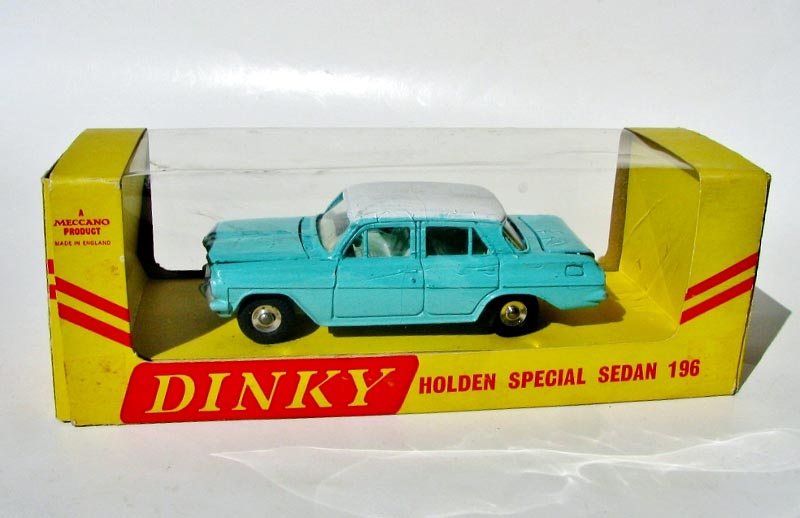
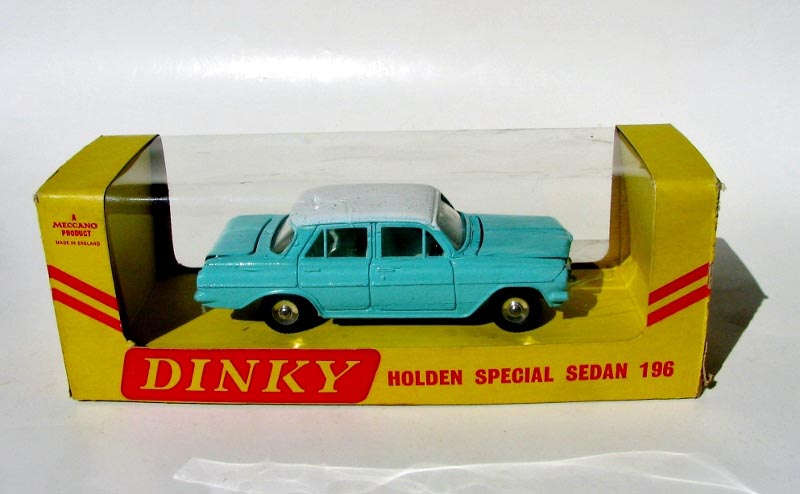
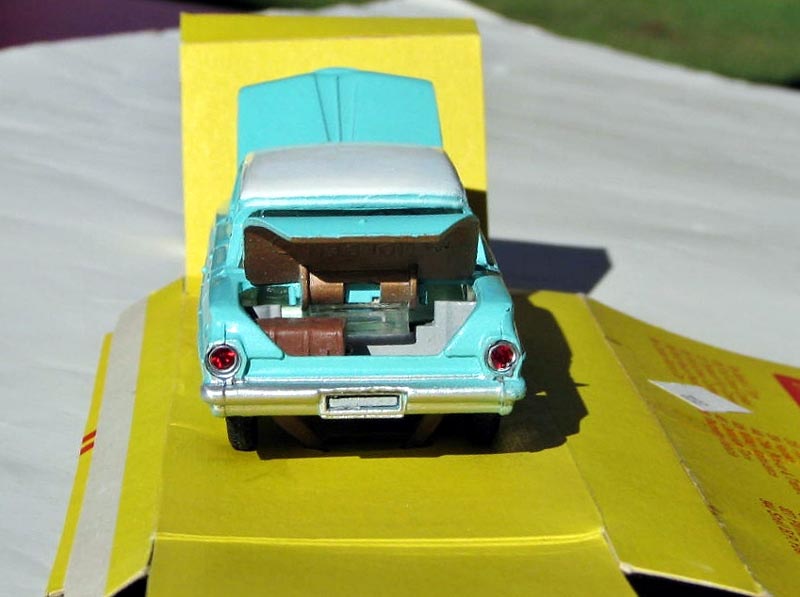
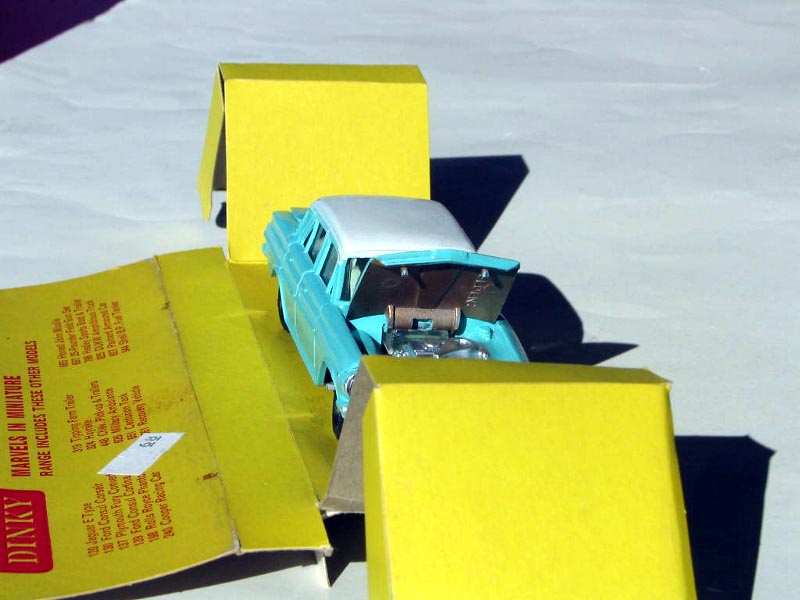

Hold up Jacques with your latest post - I am about to add a further variation, that will turn one of your suggestions into green, but first, I have to do the washing up! :unsure: Am having trouble keeping up with your posts! Bruce (150)
4001 Dinkinius
Here is another variation of the turquoise and white Holden. This one has the normal red interior, grey die-cast base plate, but the bonnet is still painted bronze underneath and is housed in the standard 196 Holden Special Sedan box. 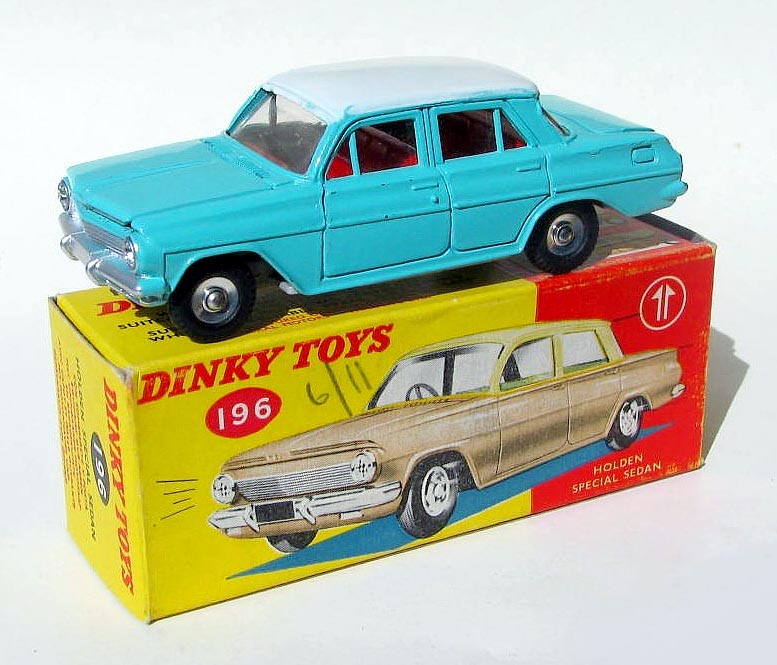
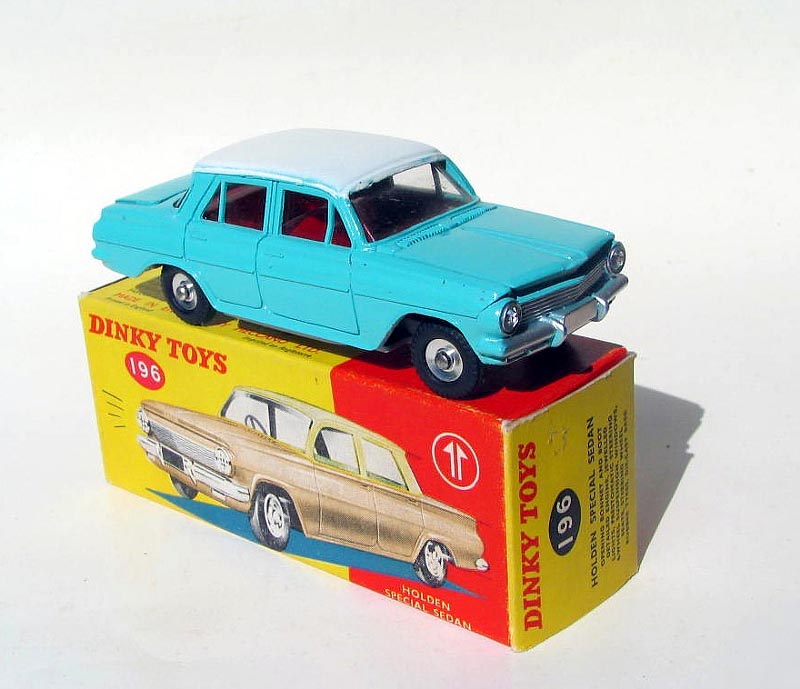
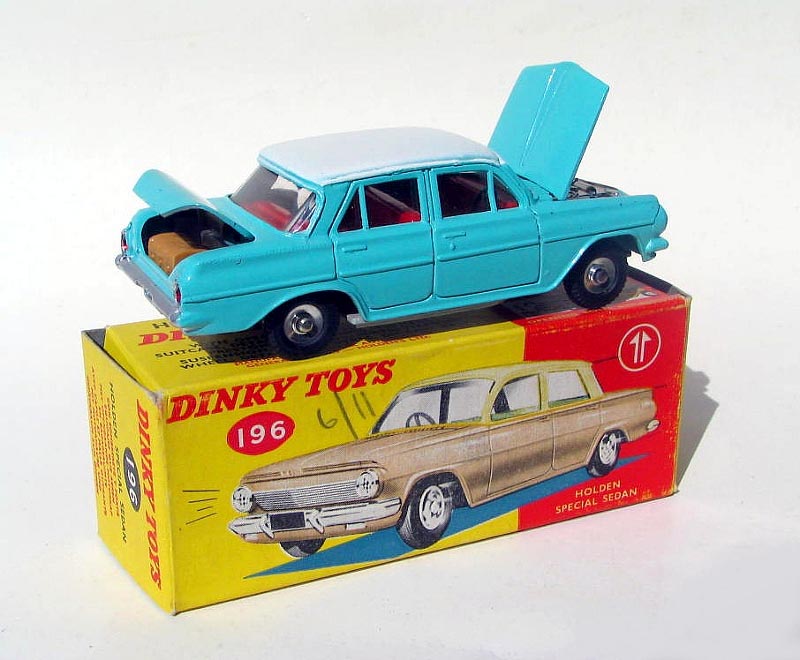
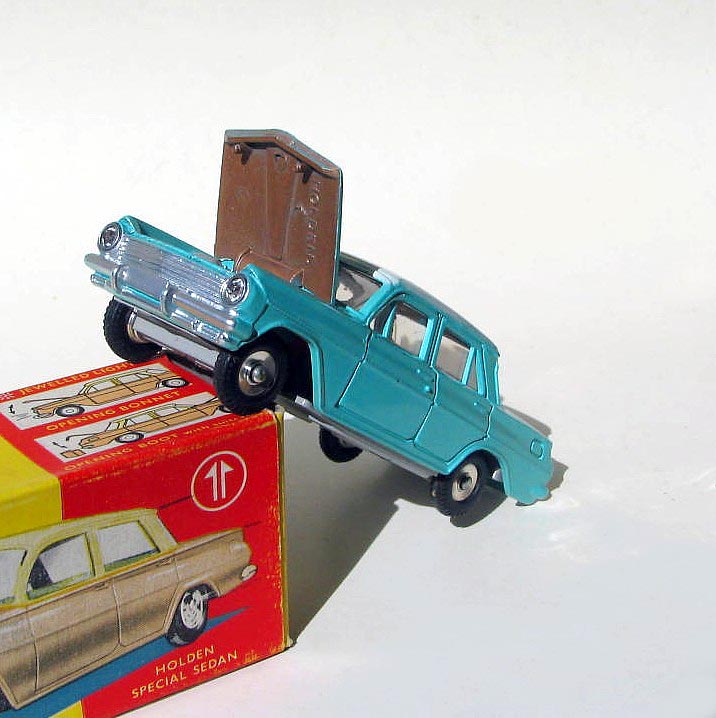
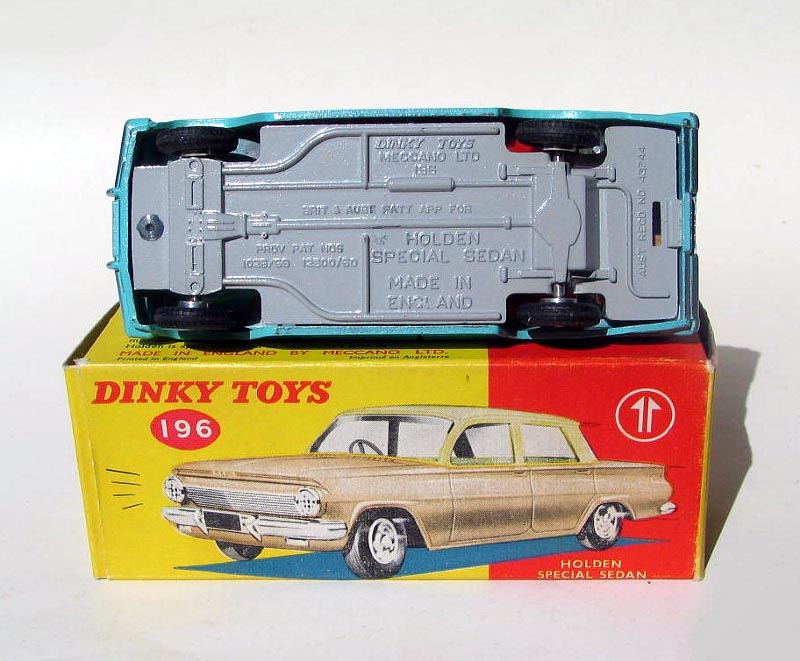
Unfortunately, I sold this model through Wallis and Wallis in 2011. Hopefully, a member or other Dinky Toys collector who won this model together with an AC Aceca in cream and dark brown Lot 429 in the Wallis & Wallis sale of 23 June 2011, may see this post and be able to check it and get back to this Thread!! By the way, whoever the winning bidder was, he got an absolute bargain, as the lot went for ninety five pounds plus commission. I have been kicking myself ever since as these were not the only models of mine that went for a song that bleak and dark day!! :(
4002 Dinkinius
This is the normal/usual version of the turquoise and white 196 Holden Special Sedan. But first a word from Dave, pinched from New Arrivals thread Re:New arrivals 13 Hours, 4 Minutes ago Karma: 6 That does not really make sense as the Holden was an Australian Car and not an American. Surely the Aussies used proper, old fashioned, English Dave ps I hope I am not opening a can of worms here!!! Dave You will see on the usual box, that we do speak and write the Queen\'s English out here, although recent years has meant we are slowly losing it, with some
changes taking place, program instead of programme, theater instead of theatre, jail and no longer gaol, yeeks, I am changing the thread!
! 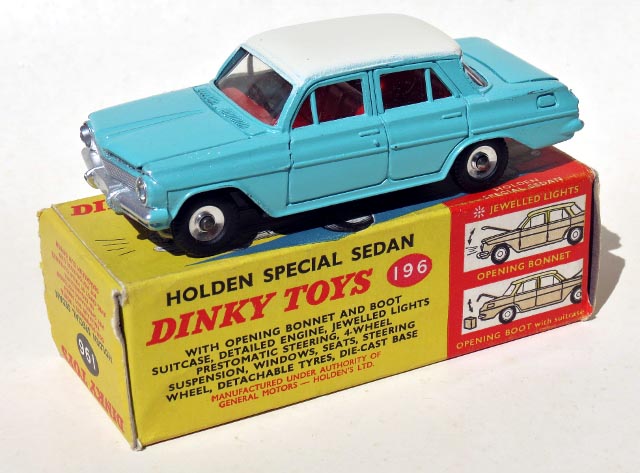
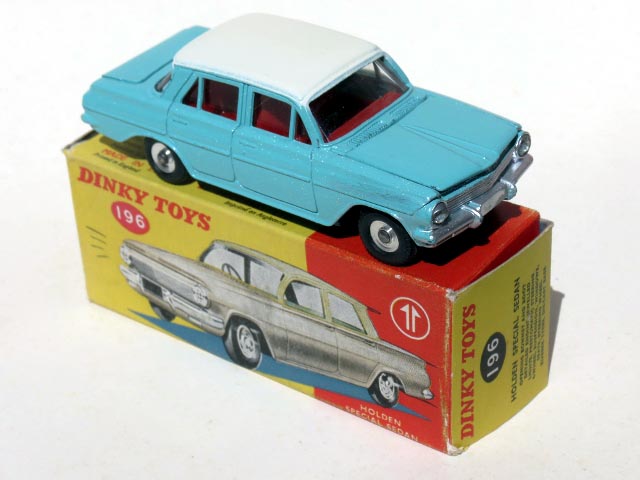
But this example now has a black diecast base plate.
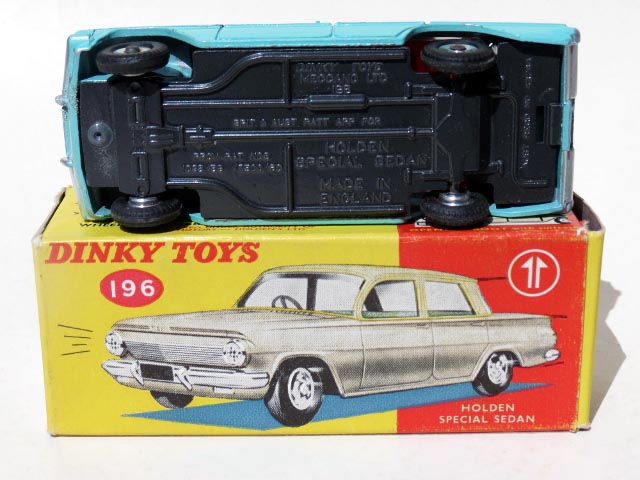
4003 Dinkinius
I guess this thread should have started with the original issue, in bronze with white (sometimes an off- white) roof. This model was released in September 1963, to mark the centenary of Meccano in Australia. Meccano worked in closely with General Motors-Holden in Melbourne, Victoria who provided basic drawings of the prototype that had been in production for about a year. The car was officially referred to as the Holden EJ Special Sedan, the model superceding the Holden EK. However, when it came to the suggested colour scheme, GM-H provided samples, and Meccano selected bronze. However, unbeknown to the fellows at Meccano, they had actually selected the colour scheme for the Holden EJ Premier Sedan, an up-market version of the Special Sedan. This was the first model in the Holden family to have a luxury model added to the range, thus acquiring the title \"Premier\", with front bucket seats, metallic paint, automatic transmission as standard (rather than an option as on the Special Sedan), heater-demister, and arm rests. (Not much comparing the features in today\'s cars!) So we have a mistake with the paintwork, which could have been rectified by simply changing the box, whoops, and the base plate. So the bronze colour continued until Meccano had exhausted the supply of this paint by the beginning of 1966. The second edition of the 1966 catalogue, effective from 21 July 1966 has the Holden in turquoise and white, a colour scheme that I have my doubts was seen on this model, although the 1966 Holden HD, a totally different designed motor vehicle appeared in turquoise and white. The catalogue no doubt reflects the period when the colour changed to turquoise and white. The model was fitted with jewelled headlights and tail lights, the first in the Dinky range to have this feature, opening bonnet and boot (hood and trunk for our brethren in North America!) It was fitted with the smaller Type 2 turned aluminium hubs and its base plate was diecast and painted light grey. The interior seats were a very pale blue, sometimes referred to as \"duck-egg blue\". The Holden was exceedingly well cast, in particular the quarter and three-quarter side window pillars. Today\'s excellent 1/43 scale models, having finer details, do not include cast pillars for the side windows, instead opting for a transfer. So the casting skills of the Meccano workers in the 1960s far exceeded those in China today!
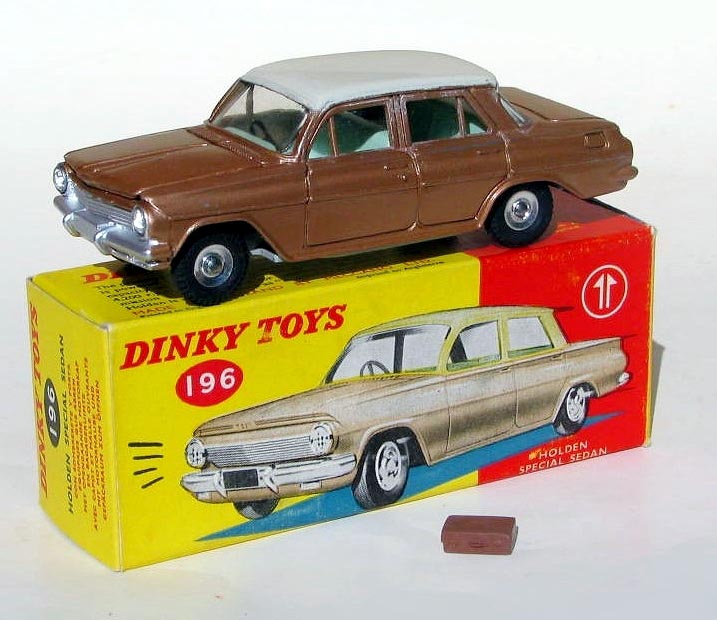
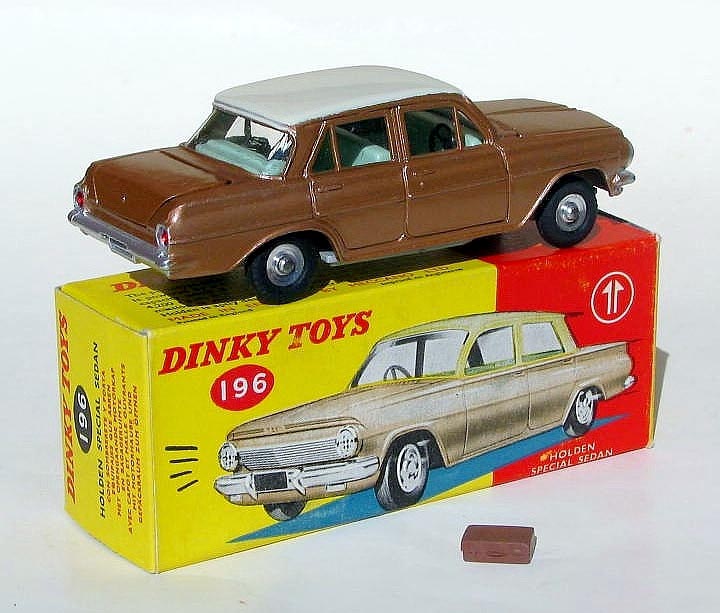
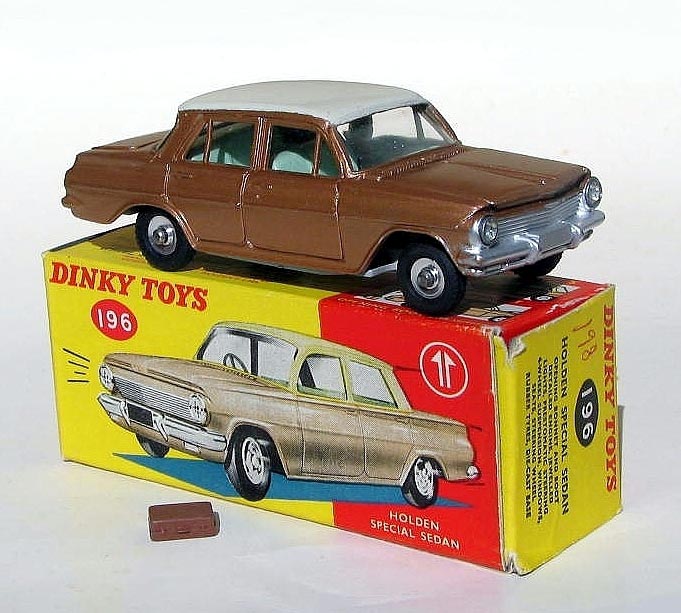
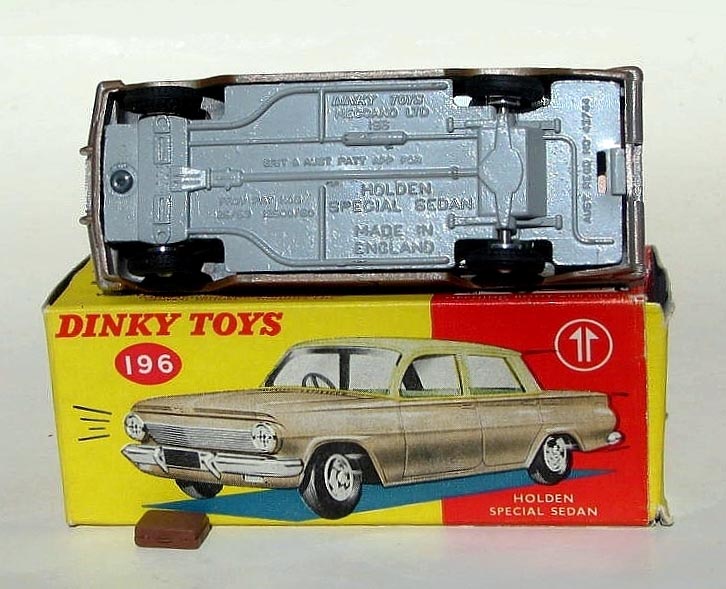
4011 Dinkinius
Jacques Referring to your question some time ago, the base plate for the model at the start of this Thread is light grey as per the bronze and white version. The interior is also identical to the bronze version, a very pale blue, or as someone referred to it as \"duck-egg blue\". I have not forgotten about the photograph you want in this thread showing the end flap and tyre details. Finally, Jacques can you explain how the painting process worked with the Holden and its bonnet and boot? If these items had been previously painted for the bronze version, how is it that only the upper was painted turquoise? Is it possible these had been fitted to the model and then the upper was given a quick spray to match the rest of the model? Bruce (150) 4017 dinkycollect Bruce, I do not know how these were painted. It is not possible that the boot and bonnets were assembled to the body before painting because they are held by the windows which are held by the base plate. I know three ways of painting used by Meccano : 1) the painting knobs 2) the x\'mas tree 3) grills I will explain later today, I must clean the garden while it is not raining. 4084 Dinkinius The following is a quote from a post submitted by Jacques some time ago: The export department in Liverpool must have been split into several sub departments for : Europe, Commonwealth, USA etc. There is evidence in some catalogues that the source for Hudson Dobson was different from the Canadian one (part of the Commonwealth). French made Dinky were exported to the US and not to Canada. So the yellow and the gold Visi- Pacs as Meccano called them may not have been available in Canada at least at the beginning. This explains why they were not printed in French for Quebec. I would appreciate a photo of the end flap showing the \"Special features\" and the tire reference as well as one of the model taken 3/4 front left so that one can see the light green seats. There are other examples of models been over-painted like the Hood and trunk of the Holden, some french Dinky trucks have been finished in that way. I can not remember which. Jacques. Jacques I have finally got around to photographing the end flap and another showing the tyre/tire reference.
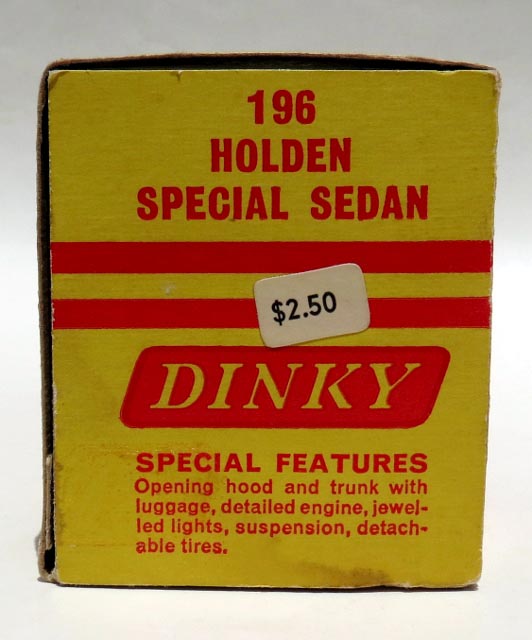
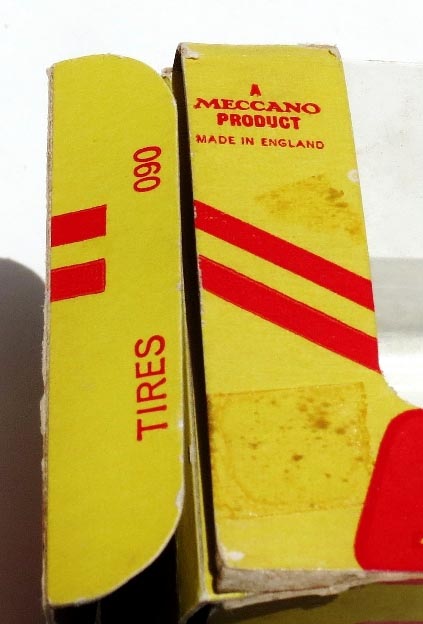
It is to be noted that the tire/tyre specification was only printed on one of the main tuck-in flaps.
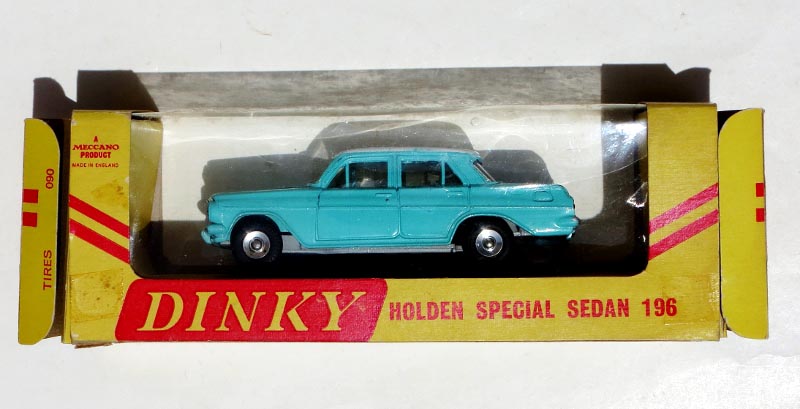
The large cardboard side that I had neglected to include previously is below. The only interesting thing is the small ticket that has been stuck to it with the numerals \"68\". I do not know what this means, but perhaps it could denote 1968.
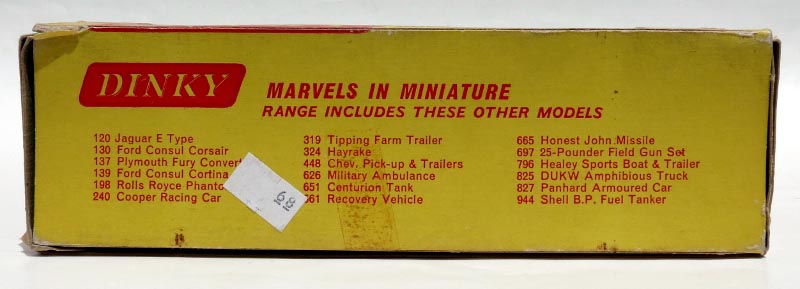
4087 dinkycollect
Bruce, Thank you for the nice pictures. 5537 Dinkinius In early July 1963, Meccano Dealers were sent a copy of the July-August-September Meccano Trade Bulletin that provided them with advance notification of six new Dinky Toy and Supertoys releases. One of these was the \"196 Holden Sedan Car - THE CAR FROM DOWN UNDER!\" Of course the model\'s title became the 196 Holden Special Sedan when it was released in September 1963, to mark 50 years of Meccano in Australia. Here is a copy of the advertisement in the Bulletin that also included the 117 Four
Berth Caravan that was released in August 1963. Bruce (150) #500
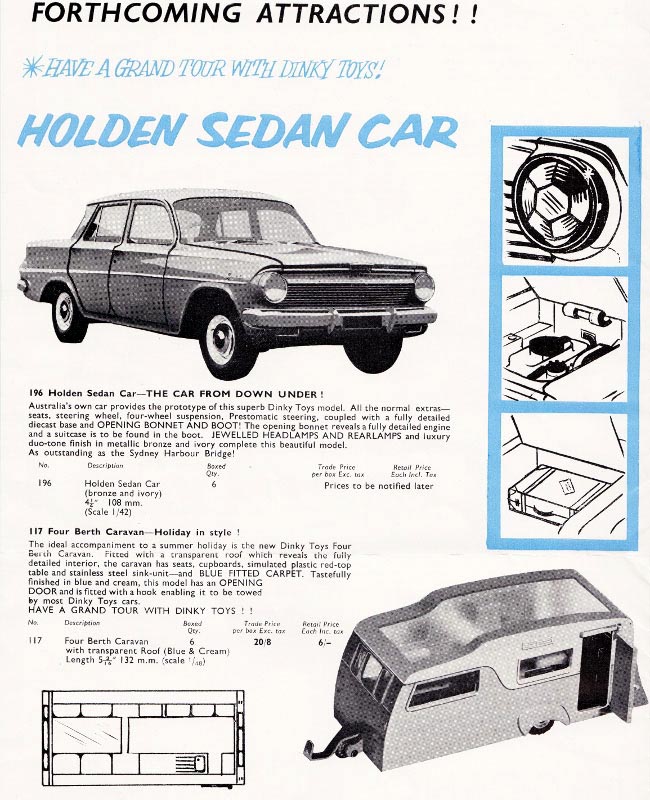
5538 STARNI999
Hi all, Lovely looking car the Holden Special, did it share floorpan etc with the PB Cresta? Chris Warr.
5539 Dinkinius
Greetings Chris Many thanks for your comments on the Holden EJ. Actually, the next version the EH was a big improvement. No - the Holden did not share a floor plan with any other vehicle. It was totally designed and engineered at Fisherman\'s Bend, near Melbourne, Victoria, Australia. Its predecessor the FB/EK was right up with the Americans - tail fins and wrap-around windscreens. General Motors-Holden built a fantastic testing ground at Lang Lang southeast of Melbourne, and all new designed Holdens from the 1958 Holden FC right through to the current Commodore (no, not the Opel one, although our Commodore had its roots with the Opel one!) were tested and modified through this test facility. In recent years, the Pontiac GTO was a re-badged and re-engined Holden Monaro, made in Victoria, Australia. Unfortunately, by 2017, General Motors-Holden will no longer manufacture or assemble cars in Australia. Their role will simply be to stick a Holden badge on appropriate products being made elsewhere by GM, such as the Opel Astra. The one redeeming factor will be the retention of the design and engineering department for a lot of GM products with the proving ground at Lang Lang being retained. Ford and Toyota like GM-H will also cease manufacturing in Australia. A sad end through globalization. In the 1950s, we had three manufacturers, GMH, Ford and Chrysler and a multitude of assemblers, BMC, Rootes, VW and others, all when we had a population of 9 million. Now with 22 million approaching 23, apparently we do not have the population to support a single car manufacturing and component industry! Unfortunately, cars will continue to be made in countries where the workers do not enjoy the same conditions as here, and whose pay packet is far less, resulting in a bigger profit for the multi-national manufacturers. But I guess this is the same story that has been repeated elsewhere, GB, etc. There - I have said my piece! Kind regards Bruce (150) #501
5541 STARNI999
Thanks Bruce, Believe me I know how you feel, coming from the West Midlands, and growing up in the 60\'s / 70\'s it seemed everybody worked in car manufacturing or parts supply, now we have nowhere near that, Terrible shame. BTW, a mate greatly improved his \'64 PB Cresta by taking out that old straight 6 and dropping in a 350ci Chevy V8, NICE. CW.
5570 Dinkinius
Greetings Chris and All Thought I would include a couple of brochures issued by General Motors-Holdens on the Holden EJ. Please excuse the artists licence - the car was not as long as it appears here! Bruce (150)
#510
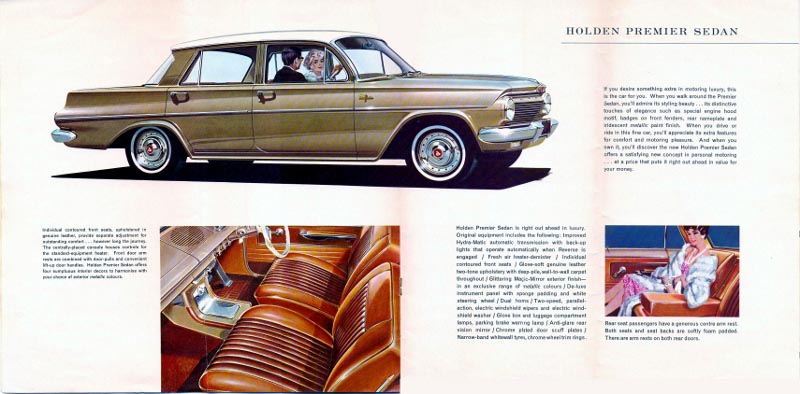

5573 STARNI999
Thanks Bruce, That wagon is amazing! Pity Dinky didn\'t model that too, was there a ute? CW
5581 Dinkinius
G’Day Chris In answer to your question whether GM-H made a utility – the answer is yes. The two-door Utility and Panel Van were released in January 1963 and these were only available in the Standard version, although many owners ultimately added extras such as chrome trim. As these were work vehicles, GM-H was not in a rush to release them at the same time as the Sedan, Premier and Station Sedan, as the previous EK model still had the utility and panel van in production for a number of months after the EJ had been released. Here are a couple of
advertisements that GM-H used to announce the arrival of the Holden EJ utility and panel van:
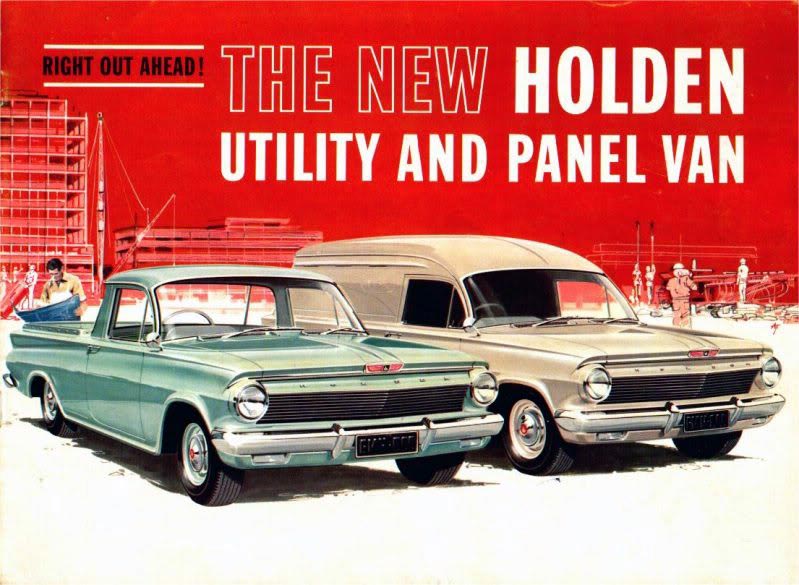

One can see the blue utility was used to draft a possible sign from a prospective buyer.
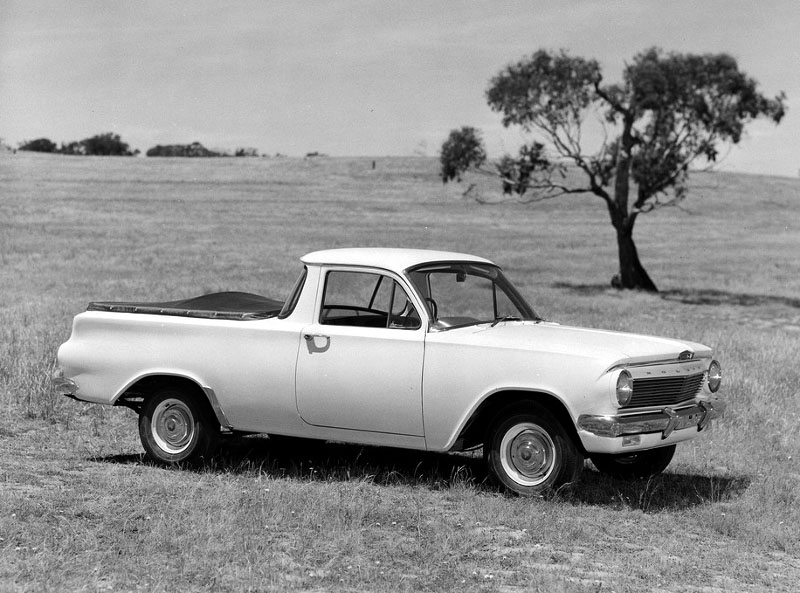
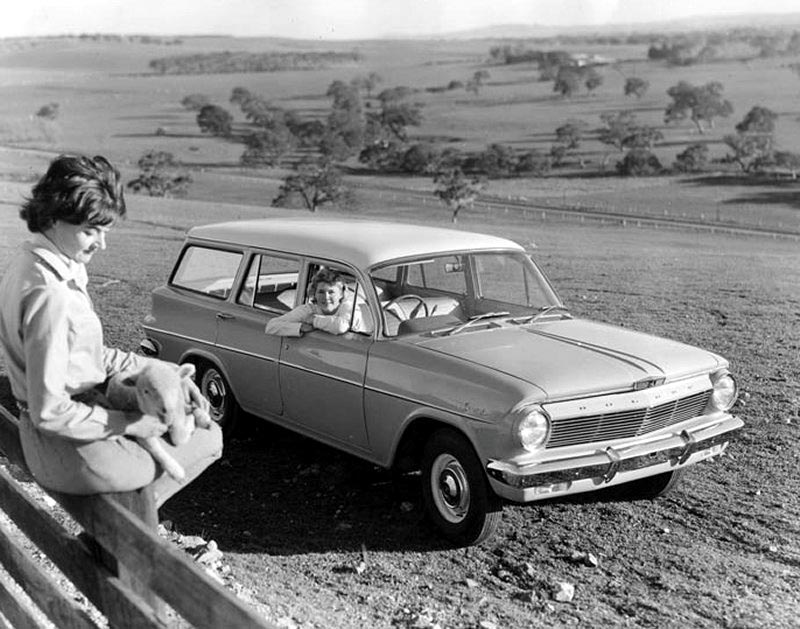
The above are publicity photographs from GM-H but I do not have anything similar for the van. I have included one on the Station Sedan as a little piece of Australiana. The photo graphically shows the wide open spaces! (That is the neighbour\'s house in the far distance!)



The last photograph is actually of an EH model, which apart from a slight change to the front grille, is basically identical to the EJ model, although the purist will probably list a multitude of minor differences! It is a shame that Meccano did not grab the opportunity to model the station sedan (wagon) and/or the utility, as I am sure it would have been a good seller in the same way as the 449 Chevrolet El Camino and the 193 Rambler Cross Country were, although the EH version of the Station Sedan had more design refinements. Cheers Bruce (150) #512
5588 STARNI999
Thanks Bruce, The panel van and Ute are really great, compared to the pick ups and car based vans we had in the UK at the time these are out of this world, our GM equivalent was the Bedford HA! Chris Warr.
5620 Dinkinius
Thanks Chris. I tend to agree with your comments. The windowless panel van was nice too, although trying to find one that has been preserved has proven too difficult! Anyhow, I think we need to go back to the beginning. In the beginning, well actually, a little later than \"in the beginning\", but Meccano wanted to mark the 50th Anniversary of the presence of the company in Australia by producing a model vehicle that was unique to Australia. On examining the Australian motor builders, their choice was limited to three manufacturers, Ford with their Falcon, Chrysler and their Valiant, and General Motors-Holden\'s with their Holden. Of the three, only Holden was manufacturing a family sedan that was entirely (with limited input from Detroit) designed and built in Australia. Both the Ford Falcon and Chrysler Valiant were products of their parent company in the United States, with some modifications to suit Australian conditions. So Meccano then sought help from General Motors-Holden\'s with their product being entirely \"Australian Made.\" The Holden EJ on which the Dinky Toys 196 is based, was released on 30 July 1962 in three body types, Standard Sedan, Special Sedan, (the 196 Dinky Toys) and the Premier Sedan. The Standard model was the base version – no frills, no chrome trim and was only available in a single colour, costing ₤885 with the Special costing ₤935. The Special had plenty of chrome as well as the model was available in a selection of dual colours in addition to a selection of upholstery that matched the exterior paintwork. The Premier, the first Holden in this higher quality trim, had leather upholstery, two bucket seats in the front, front centre console, glove box and luggage compartment (boot/trunk) lamps, available in an exclusive range of metallic paint (Dinky Toys equivalent of Polychromatic Paint), centre armrest for the back seat passengers, heater, automatic transmission with reversing lamps, narrow band whitewall tyres and other features priced new at ₤1195. Metallic paint was not available with the other two levels of Standard and Special. Yet, despite all the added “luxury” equipment, like the Standard and Special, the Premier was not fitted with a radio! The occupants had to actually talk to one another, as well as provide their own music! Here
are two advertisements on the new Holden EJ in the Premier, Special and Standard versions.
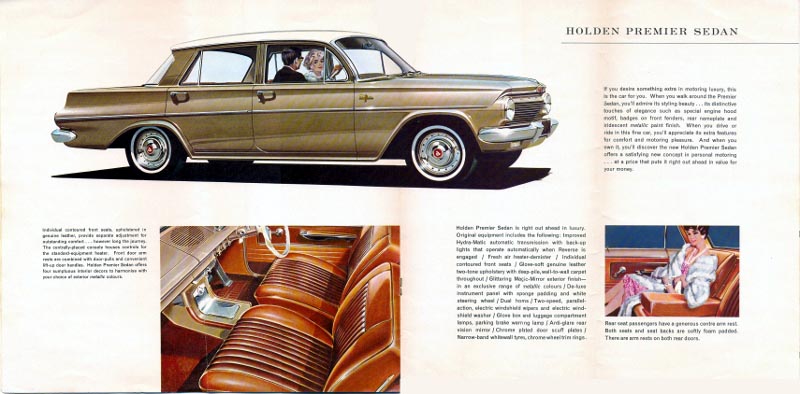
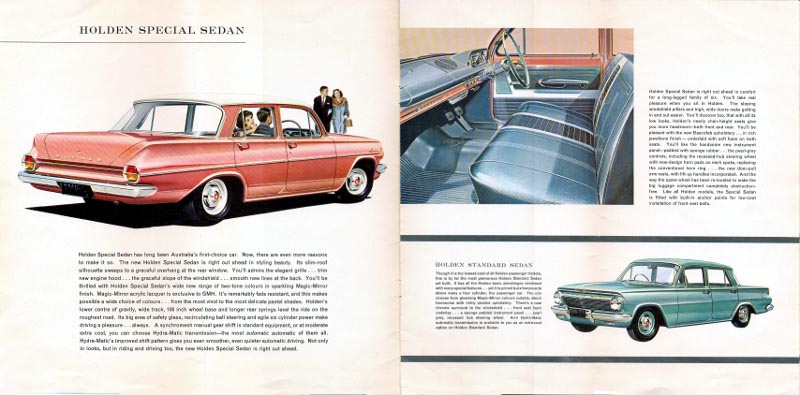
Released at the same time was a four-door station wagon that GM-H referred to as a STATION SEDAN, dispensing with the American “Wagon”. This version was only available for the Standard and Special models. The Standard cost ₤960 and the Special ₤1010. The Premier became
available in the Station Sedan with the next model Holden, the EH.
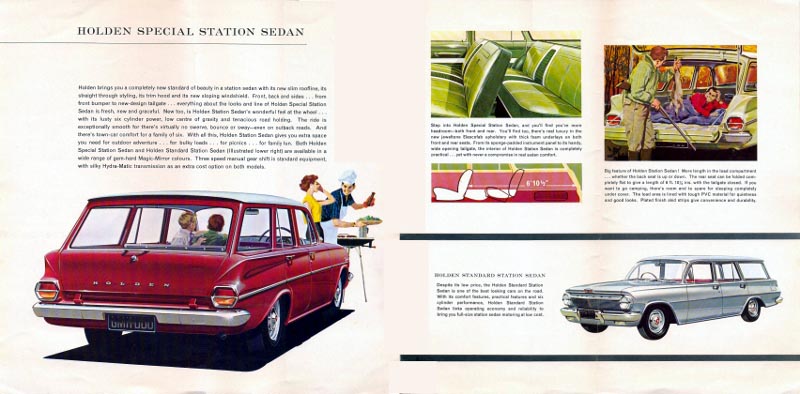
The total production for all Holden EJ units was 154,811. On 26 October 1962, the 1,000,000 Holden rolled off the production line that happened to have been a Premier. The first Holden came off the assembly line on 29 November 1948. It took only a further six and a half years until 3 March 1969 when the 2,000,000 vehicle rolled off the assembly line, indicating that by the 1960s, Australian lifestyle was becoming more affluent. The Holden EJ series was replaced by the Holden EH series that incorporated some bodywork changes in August 1963. This model had the highest production figure of 256,959 units from August 1963 to February 1965 until the arrival of the Holden HQ Belmont/Kingswood in July 1971. It was perhaps a little sad that when the Dinky Toys 196 Holden Special Sedan was released in September 1963, the model had just been superseded by
Holden EH.
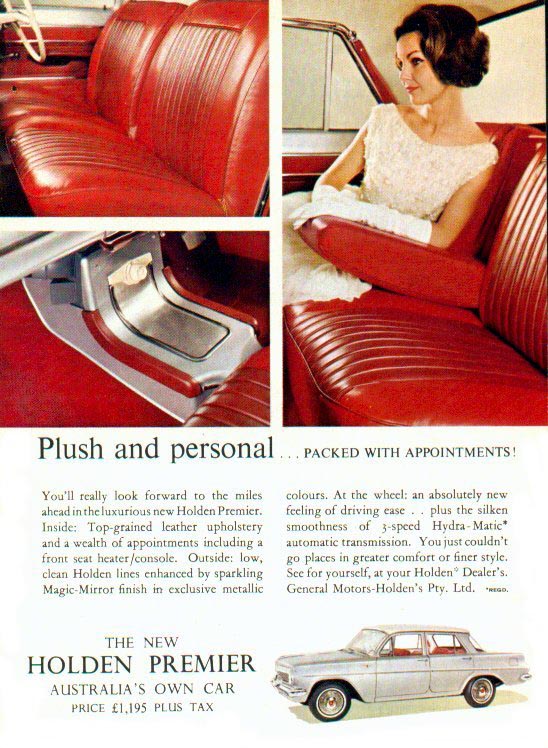

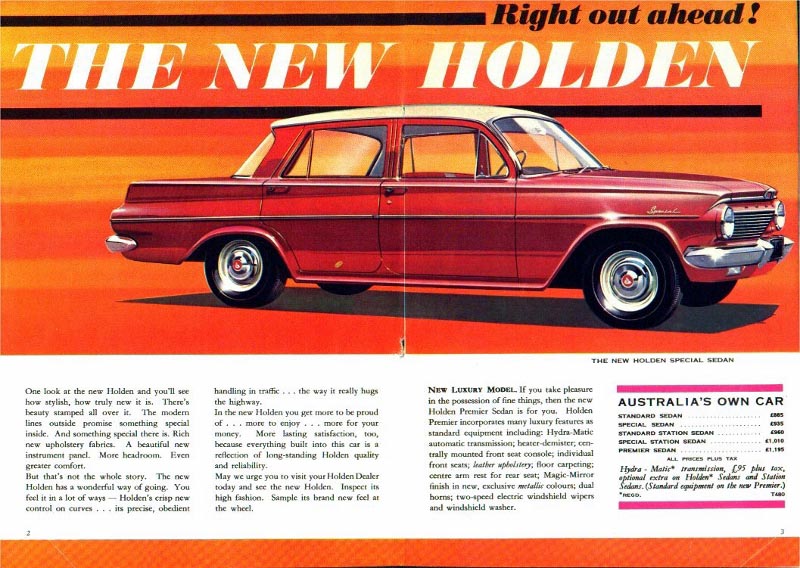
DINKY TOYS 196 HOLDEN SPECIAL SEDAN Now, let’s talk about the 196 Holden Special Sedan that was initially issued in polychromatic bronze with a white roof. Interesting to read in the Dinky Toys News for September 1963 that the Holden was painted in metallic bronze (no mention of polychromatic this time) and has opening bonnet and boot, the first Dinky to have both these features. In addition the model came with a little plastic suitcase, and a new innovation, “red and clear “jewels” for the headlights and taillights that are intended to reflect light giving the appearance that the lights are on. This is how the boys and girls were informed of the arrival of this new model:
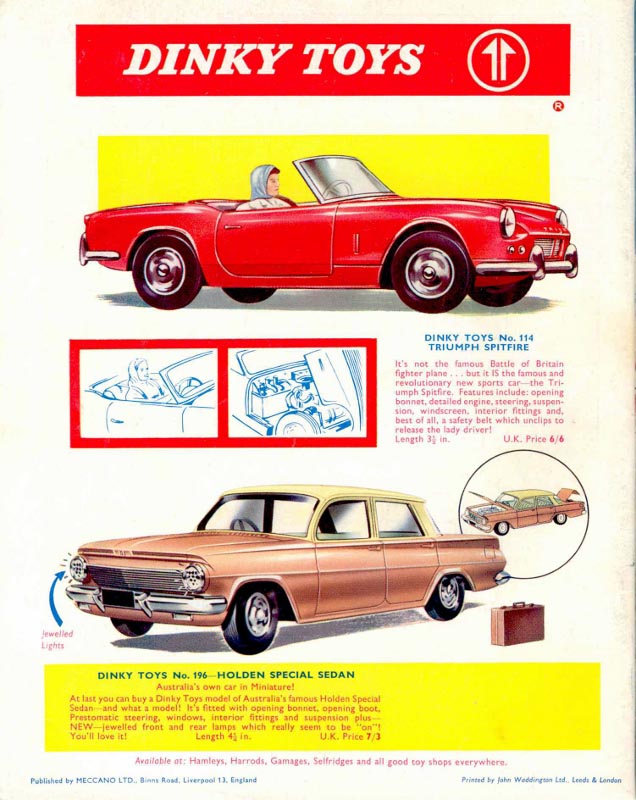
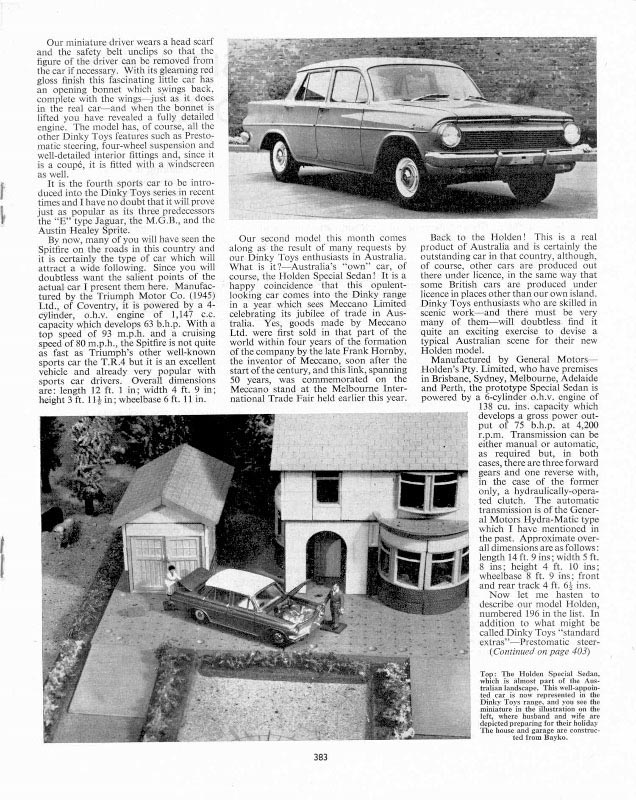
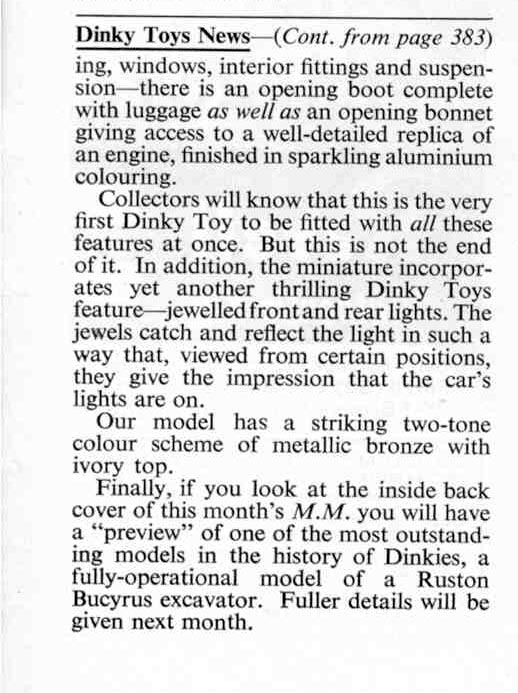
However, for the purest, 196 is NOT a Holden Special Sedan for two reasons. Firstly the model is painted in a metallic paint which was not available for the Special Sedan. Secondly, and this one I had not noticed previously until I pulled out my Holden book and read that the seats were those for the Premier – individual seats for the front and moulded individual seats for the rear, whereas the Special Sedan had a bench seat front and rear. Never noticed that before now!! It is also of interest that the artist’s rendition of the model for the advertisement has the roof colour extending
to the bottom of the windows Here are two pictures of the Holden Premier in Euroa Gold and Atherton Ivory.
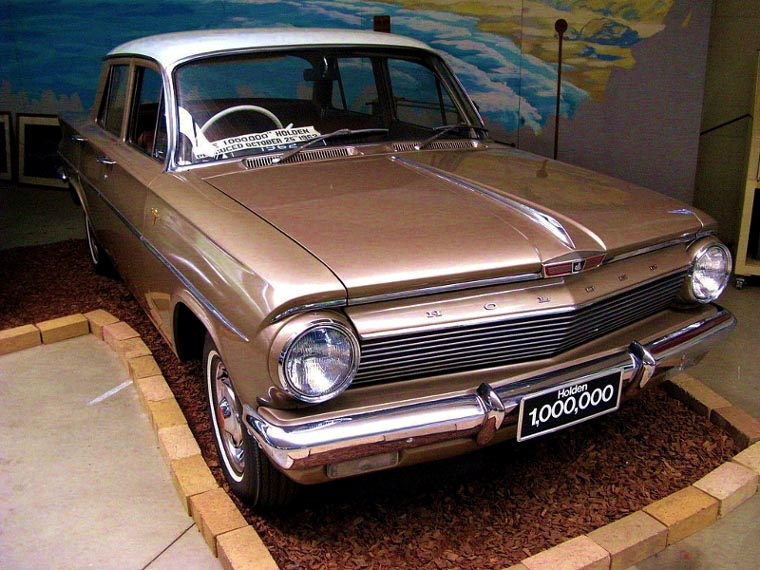
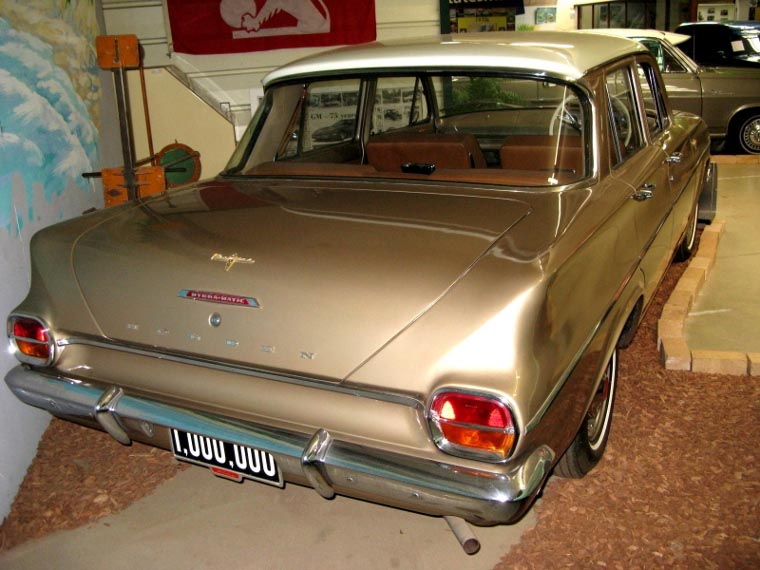
As can be seen, the above Holden Premier also happened to have been the 1,000,000th Holden manufactured in Australia with this car coming off the line on 25 October 1962. (The 900,000th Holden rolled off the assembly line in Brisbane, Queensland on 7 February 1962, the 109,952 Holden assembled in the Brisbane plant.) Also, notice the boot/trunk. The red badge above the keyhole states \"Hydromatic\", the Holden terminology for automatic. Above this badge is a further badge that states \"Premier\" A similar badge can be found on the upper front mudguard towards the rear. (The Special also has its own badges, and these are only on the front mudguards above the chrome strip and close to the headlights.) With the Special Sedan being the decided name for the model, there was a similar non-metallic paint used for both the Special and Standard models, a “Magic Mirror” acrylic lacquer from vivid to the most delicate pastel shades. This was Bunyip Bronze with Atherton Ivory roof, the acrylic lacquer equivalent to the metallic Euroa Gold . Perhaps the word “bronze” threw Meccano out thinking that “bronze” equals metallic. Here is the
Holden Special Sedan in Bunyip Bronze:

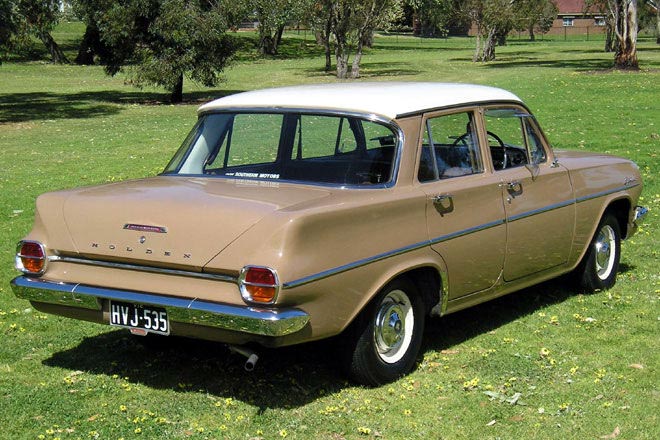
And this is the model that we collectors received, all resplendent in its Meccano equivalent of Euroa Gold and Atherton Ivory roof:
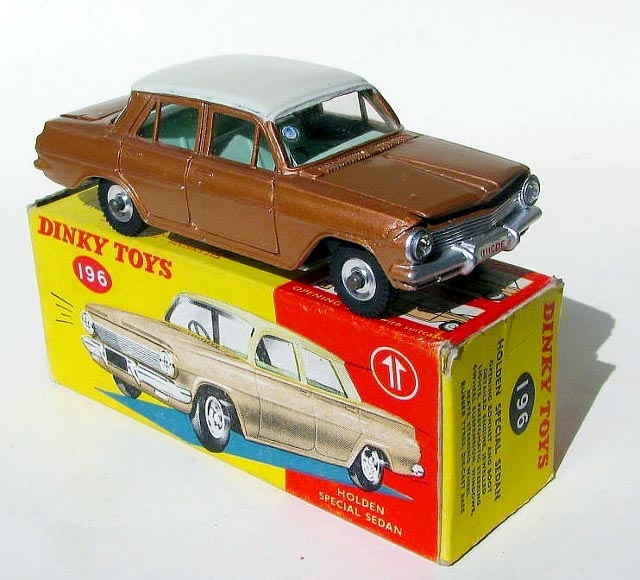
In fact buyers of the real Holden EJ Special Sedan had a choice of 18 colours in two tone, and in many cases, a combination could be selected; the primary body colour could be used for the roof with Atherton Ivory the usual roof colour being the primary body colour . In effect, a buyer had a choice of 32 single or combinations from which to select although not all the primary colours were reversed. For the Premier, there was only a choice of four combinations, Euroa Gold, Theatre Grey, Hotham Blue and Wimmera Green, all having an Atherton Ivory roof. How many modern-day manufacturers offer such a wide choice of not only colours but where each colour was used. Three years later, Meccano changed the colour scheme of the 196 Holden Special Sedan with it now having a turquoise body, a white roof and red interior. Whether this came about due to Meccano realizing, or GMH advising them, that having a model denoted as a Special Sedan whose colour was that of a Premier, is unknown. Whatever the reason, Meccano selected an appropriate colour scheme that was used for the Special Sedan. Its factory name was Tamar Turquoise with Atherton Ivory roof. Unfortunately, Meccano should have retained the interior of the Bronze version, as this was very close to the actual colour used for the upholstery for this colour scheme of the Special Sedan. (A few Tamar Turquoise models did have the pale blue
interior of the first version until the stock had been exhausted.)
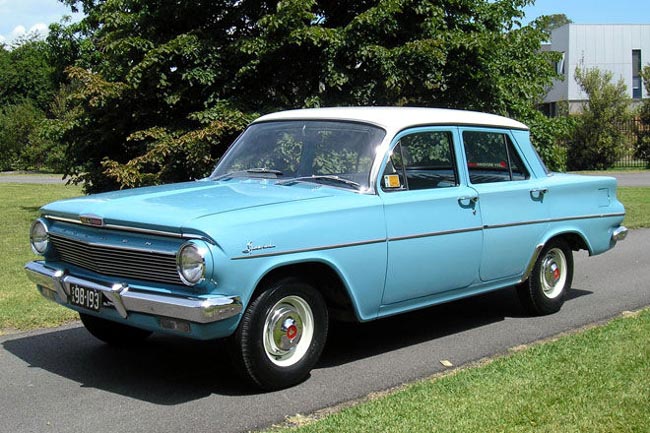
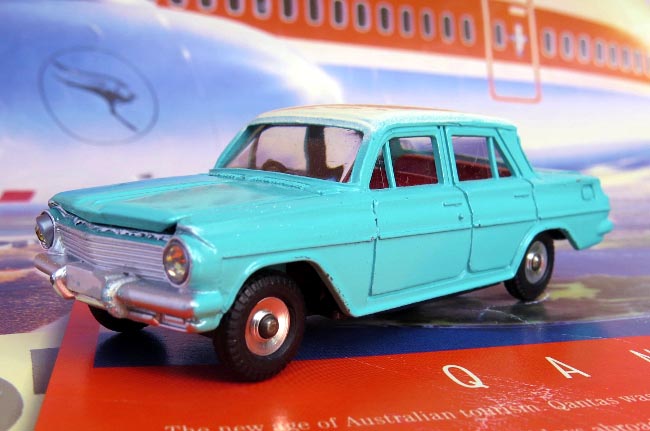
Here is the actual car in Tamar Turquoise and Atherton Ivory roof and next to it, the Dinky Toys 196 Holden Special Sedan, now in the true colours of a Special Sedan with a true blue Australian icon in the background, a period advertisement for QANTAS! To end this treatise on the 1962 Holden Special Sedan, here is the latest and unfortunately, last Holden to be built in Australia, the Holden SS-V Commodore. (Yes, for those from Europe, Holden \"borrowed\" the name Commodore from another General Motors product, the Opel Commodore.) Of course we still have another two years of manufacturing, so no doubt GM-H will undertake some minor tweaking to keep the model current and a little \"new\", but come 2017, that will be it. Farewell Holden! Welcome re-badging which Holden have already been doing for years such as the Astra and the current Cruze and Colorado. :(

Kind regards Bruce (150) #520
5621 STARNI999
Wonderful! Thanks Bruce! Great lot of info there. I\'ve had lots of American cars over the years, and am pretty clued up on them, but my knowledge of Australian cars is pretty poor. Something to work on! Anyway, I saw a Bayko house in the Meccano advert, and as I just happen to have one built, and a Holden....
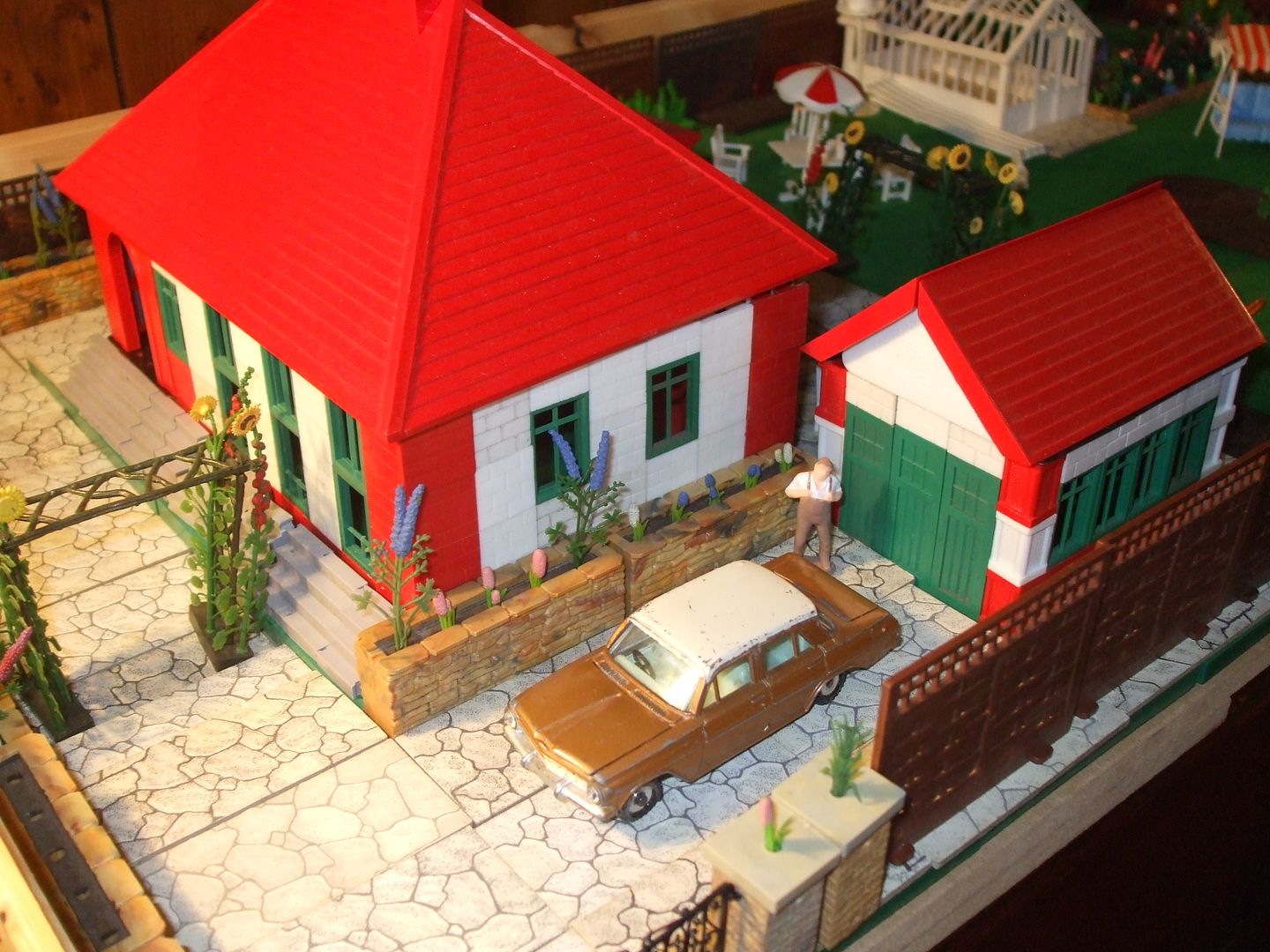
Chris Warr. BTW; I\'m a huge fan of Bayko, I\'ve bought tons of it over the years, is it relevant to start a Bayko post here? Anybody interested?
5818 Dinkinius
Greetings all Returning to the 196 Holden Special Sedan (aka Holden Premier Sedan!) the engineers, tool-men, and all those associated with preparing the die, performing the casting operation, etc, were light-years away from those making die-cast models these days, now mostly in China. We often read of the skills etc from the Chinese plants, but look carefully at the following picture. It is of a fairly recent model in the Trax (Australia) range, depicting the same Holden EJ that Meccano produced 40 years previously. Notice the quarter front side window vent and the three-quarter fixed rear window. With the Dinky version the frames for these two side windows are die- cast metal. The modern version is simply a silver transfer.
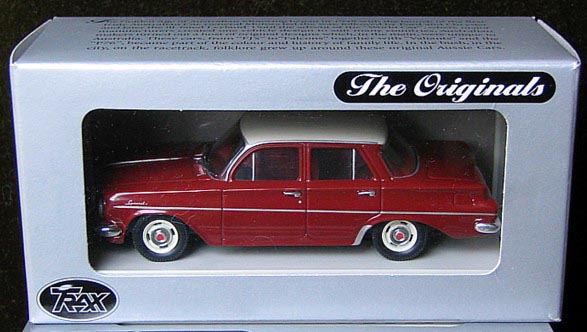
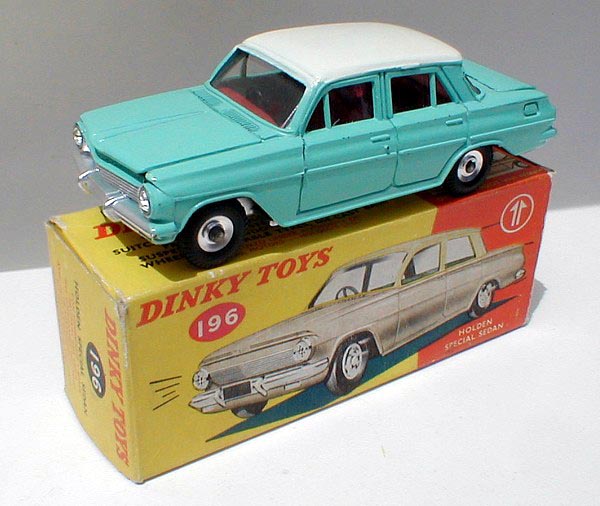
Although giving credit where it is due, the modern version has realistic wheel rims, and perhaps the casting itself may be superior, nonetheless, this model has been made exclusively as a COLLECTOR\'S MODEL, not as a TOY ! And Meccano, and its skilled workers, was still able to cast the model with metal frames for the side windows. Cheers Bruce (150) #544 6 May 2015
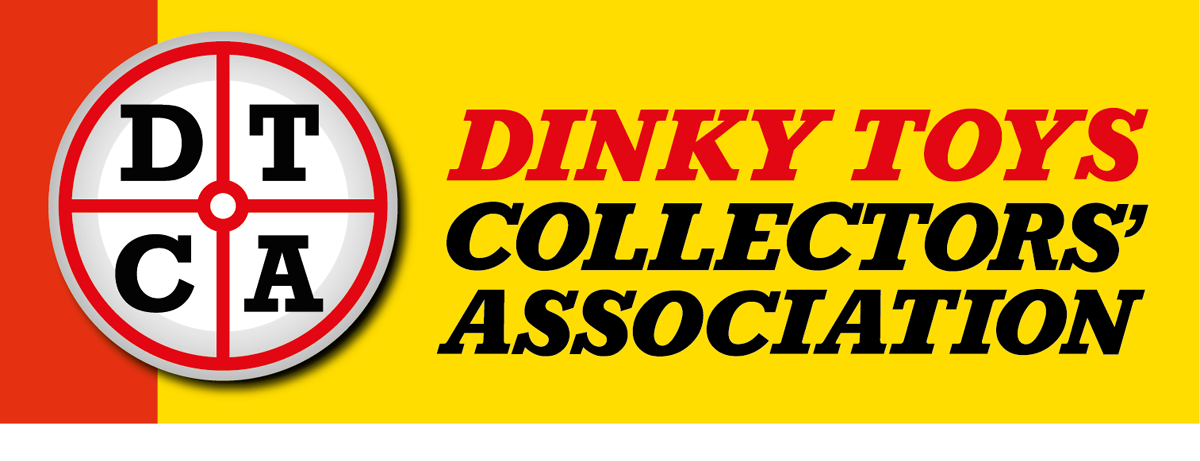

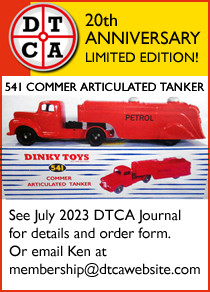
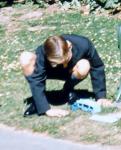
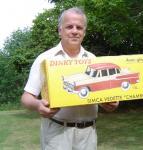
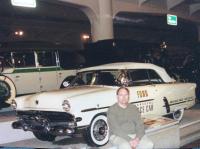


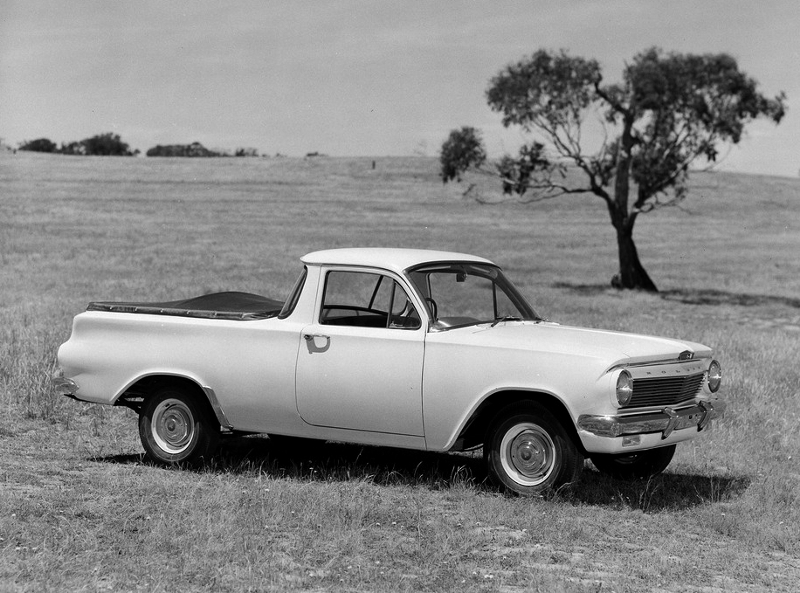


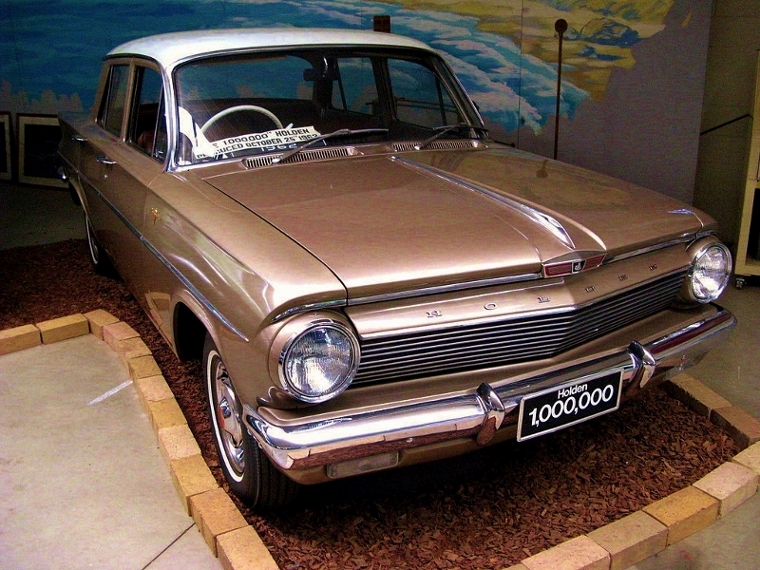
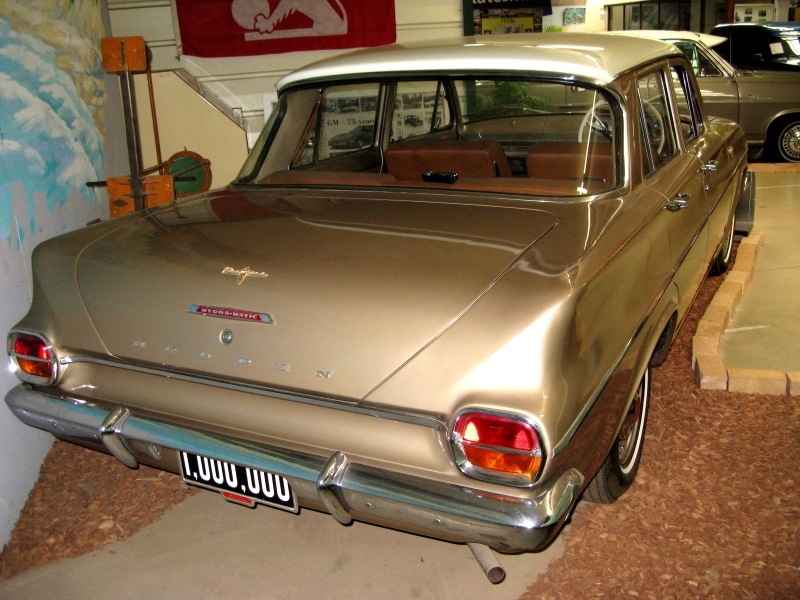
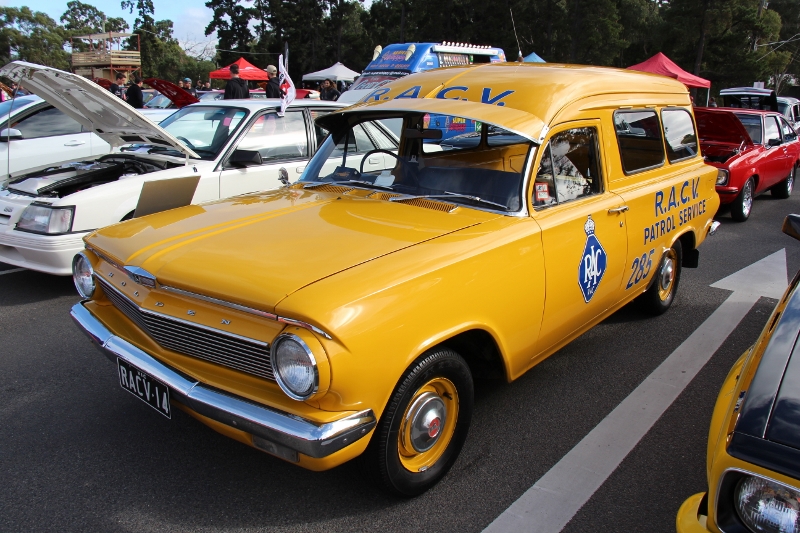
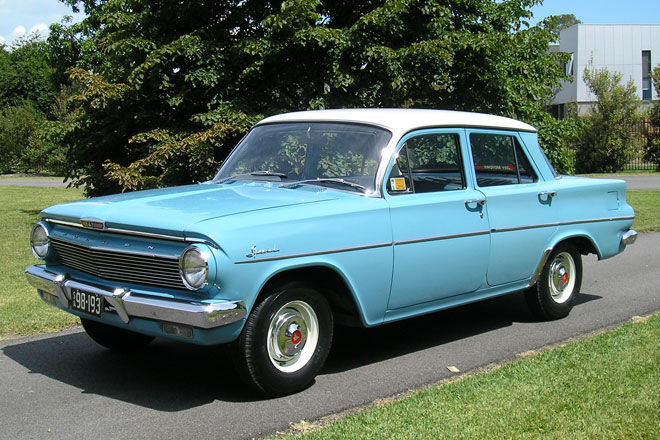

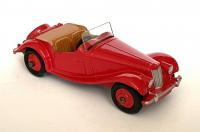
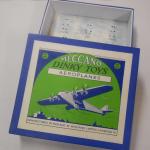
-073 Land Rover, Horse Box and Horse (1960-67)
DTCAwebsite upgrade 2023
DTCAwebsite upgrade 2023
-105c and 383 4-Wheel Hand Truck (1949-1958)
-105c and 383 4-Wheel Hand Truck (1949-1958)
DTCAwebsite upgrade 2023
DTCAwebsite upgrade 2023
DTCAwebsite upgrade 2023
DTCAwebsite upgrade 2023
DTCAwebsite upgrade 2023
DTCAwebsite upgrade 2023
DTCAwebsite upgrade 2023
DTCAwebsite upgrade 2023
DTCAwebsite upgrade 2023
DTCAwebsite upgrade 2023
DTCAwebsite upgrade 2023
DTCAwebsite upgrade 2023
DTCAwebsite upgrade 2023
--22c Motor Truck (1933-50)
--22c Motor Truck (1933-50)
DTCAwebsite upgrade 2023
DTCAwebsite upgrade 2023
Trailer Caravans
Trailer Caravans
DTCAwebsite upgrade 2023
DTCAwebsite upgrade 2023
DTCAwebsite upgrade 2023
DTCAwebsite upgrade 2023
Trailer Caravans
Trailer Caravans
-138 Hillman Imp (1963-73)
-537 Renault 16 TL
-189 Triumph Herald Saloon (1959-64)
-255 Mersey Tunnel Police Van (1955-61)
DTCAwebsite upgrade 2023